Paul van Yperen's Blog, page 438
November 13, 2013
Bobbejaan Schoepen
Flemish singer-songwriter, guitarist, comedian, actor and professional whistler Bobbejaan Schoepen (1925-2010) was a pioneer of the Belgian pop music, vaudeville and the European country music. He was the first Belgian singer who had an international breakthrough and who appeared in international films. He was also the founder and former director of the amusement park Bobbejaanland. And in 1957 he represented Belgium at the Eurovision Song Contest.
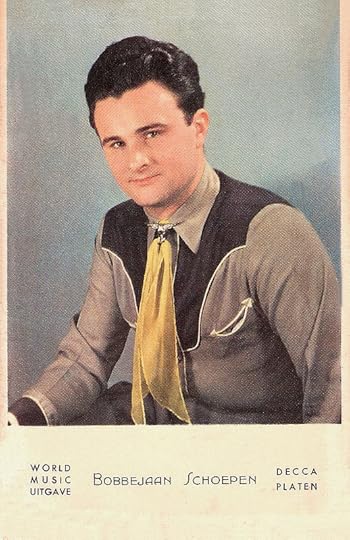
Belgian postcard by World Music, Brussel. Photo: Decca.
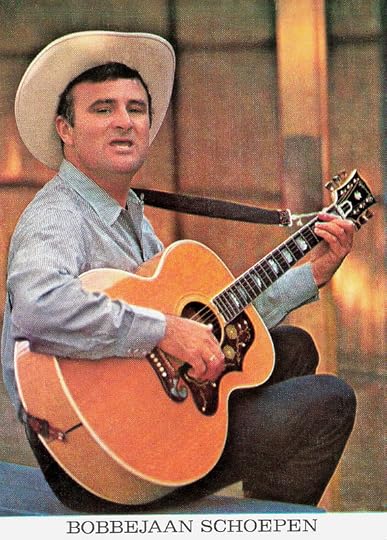
Belgian postcard by Samo Chips.
European Country Music
Modest Hyppoliet Joanna Schoepen was born in Boom, Belgium in 1925.
He made his stage debut in 1943 in the famous music hall Ancienne Belgique in Brussels. He sang the South-African song Mama, ‘k wil ‘n man hé. Neen mamma, nee, ‘n Duitseman, die wil ek nie. Want Schweinefleisch dat lus ek nie (Mommy, I want a husband. No mommy no, I don’t want a German ‘cause I don’t like pig meat.) The song was perceived as being anti-German, provoking a few Nazis who were present at the show to take him away. The Ancienne Belgique was closed for three weeks.
Shortly thereafter he was forced to go work in Germany. As an alternative he chose to sing for the Flemish workers doing compulsory labour. For this he was locked up for three months in the Dossin barracks in Mechelen from October 1944, without a hearing or a trial.
In 1945 he and his village friend Kees Brug formed the duet Two Boys and Two Guitars, which had a repertoire of imitations, poems and South-African and country songs plus a lot of improvisation and adventure. He started to use the name Bobbejaan, from a South-African song.
In 1947 he met manager Jacques Kluger, who arranged engagements for him to perform for the American and Canadian troops in Germany. In 1948 he had his first hit with De Jodelende Fluiter (The Yodelling Whistler). He was a virtuoso whistler, a gift he lost after an operation.
Bobbejaan became the first Belgian singer with international success. He toured through more than 20 countries, and performed with stars like Josephine Baker , Caterina Valente , Gilbert Bécaud , Django Reinhardt and Toots Thielemans, the latter two were guitarists in his band in respectively 1948 and 1951.
Bobbejaan (in America: Bobby John and in France: Bobbi-Jean) was the first to use modern material, his own touring bus and circus tent, and a system of artist’s sponsoring. He introduced European country music in Western Europe, and in 1953 he performed in the Grand Ole Opry in Nashville, one of the most important country music halls in the US.
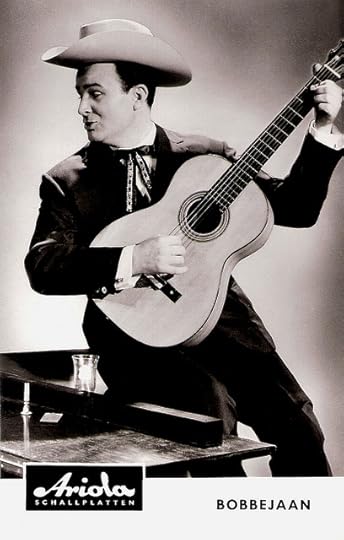
German postcard by Ariola.
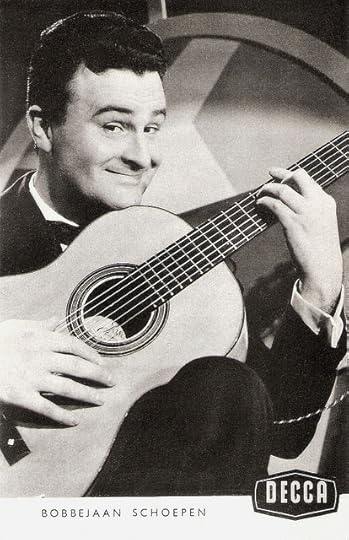
Belgian postcard by Decca.
Cult Phenomenon
In 1957 Bobbejaan Schoepen represented Belgium at the second Eurovision Song Contest with the song Straatdeuntje (Street Tune). The performance is memorable in featuring a whistling solo. Schoepen is rumoured not to have known which song he was to perform at the Contest until he arrived, only rehearsing his entry a few days before performance. Belgium ended up tying for eighth place with the Swiss entry (out of ten entries).
He had more luck with the international hits Ik heb eerbied voor jouw grijze haren/Ich hab Ehrfurcht vor Schneeweißen Haaren (I honour your grey hair), the parody Café zonder bier/Ich steh an der Bar und ich habe kein Geld - covers of A pub with No Beer by Slim Dusty, and the chanson Je me suis souvent demandé (I was often asked).
He performed another hit song, Kili watch (a cover of The Cousins), in the German film Davon träumen alle Mädchen/That's What All the Girls Dream About (Thomas Engel, 1961).
He appeared in five film musicals in both Belgium and Germany. starting with Ah! 't Is zo fijn in België te leven/Ah, it's so good to live in Belgium (Jacques Loar, E.G. de Meyst, 1950) and ending with Bobbejaanland (Vladimir Sis, 1971) .
The absurdist comedy De Ordonnans/At the Drop of a Head (Charles Frank, 1962) became a cult phenomenon, when the band Dead Man Ray made a tour with the film in the 1990s.

Dutch postcard by Editie Harry Botschuijver, Amsterdam, no. A 15. Retail price: 18 ct. Photo: World Music Company, Bruxelles. The song Anneliese (1953) was composed by Hans Arno Simon (music) and Aleda-Jan Reno (Dutch text).
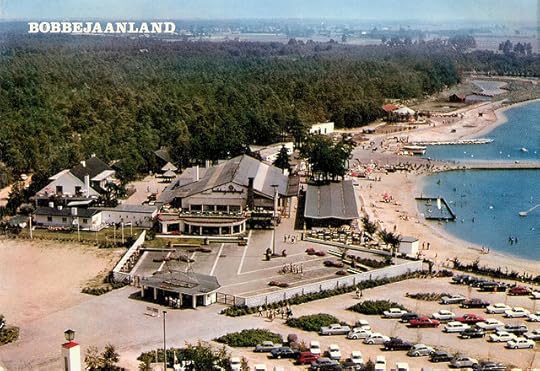
Belgian postcard by S.P.A.D.E.M., no. A 92-11. Sent by mail in 1974.
Bobbejaanland
From the 1970s on, Bobbejaan Schoepen focussed entirely on Bobbejaanland, which he had founded in 1961. The park, which was managed by Schoepen and his family, expanded to one of the most popular amusement parks in the Benelux.
When Bobbejaan was diagnosed with cancer in 1999 (he would later recover from this illness) he decided to sell the park.
Since the sale in 2004 he focussed again on his musical career. In 2008 he released his newest album, Bobbejaan. It got favourable reviews and a lot of media attention in Belgium.
In 2007 he was awarded a Lifetime Achievement Award (ZAMU Award) in the Ancienne Belgique for his pioneering role in the Belgian music history. In 2008 the International Whistlers Convention gave him as the first European a place in the Whistlers Hall of Fame. In 2009 he was made Officier in de Kroonorde (Officer of the Crown Order), by the Flemish government.
Schoepen was a true professional who was able to turn his jazzy country-guitar playing, his deep, angelic voice and his wacky sense of humour into a trademark. Between 1948 and 1970 he sold more than five million copies from his repertoire of nearly 600 songs.
Bobbejaan Schoepen suffered a cardiac arrest in a hospital in Turnhout in 2010. The day before he had enjoyed his 85th birthday. He was married to Dutch former opera singer and photo model Josephina (Josée) Jongen, who passed away on 13 September 2013. They had five children: Robert ('Bob jr.', 1962), Myriam (1963), Jacky (1964), Peggy (1968) and Tom (1970).
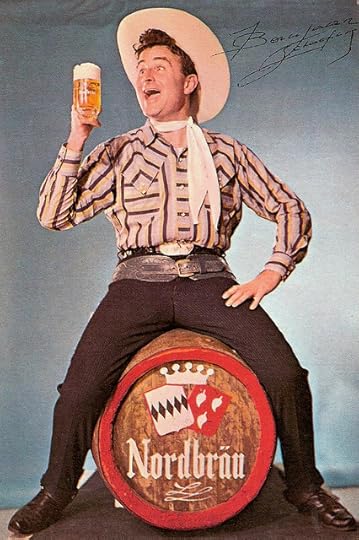
Belgian postcard by Imp. Laline s.a., Jemappes. Publicity card for Nordbräu Beer.
Sources: Bobbejaan Schoepen, Wikipedia, and .

Belgian postcard by World Music, Brussel. Photo: Decca.

Belgian postcard by Samo Chips.
European Country Music
Modest Hyppoliet Joanna Schoepen was born in Boom, Belgium in 1925.
He made his stage debut in 1943 in the famous music hall Ancienne Belgique in Brussels. He sang the South-African song Mama, ‘k wil ‘n man hé. Neen mamma, nee, ‘n Duitseman, die wil ek nie. Want Schweinefleisch dat lus ek nie (Mommy, I want a husband. No mommy no, I don’t want a German ‘cause I don’t like pig meat.) The song was perceived as being anti-German, provoking a few Nazis who were present at the show to take him away. The Ancienne Belgique was closed for three weeks.
Shortly thereafter he was forced to go work in Germany. As an alternative he chose to sing for the Flemish workers doing compulsory labour. For this he was locked up for three months in the Dossin barracks in Mechelen from October 1944, without a hearing or a trial.
In 1945 he and his village friend Kees Brug formed the duet Two Boys and Two Guitars, which had a repertoire of imitations, poems and South-African and country songs plus a lot of improvisation and adventure. He started to use the name Bobbejaan, from a South-African song.
In 1947 he met manager Jacques Kluger, who arranged engagements for him to perform for the American and Canadian troops in Germany. In 1948 he had his first hit with De Jodelende Fluiter (The Yodelling Whistler). He was a virtuoso whistler, a gift he lost after an operation.
Bobbejaan became the first Belgian singer with international success. He toured through more than 20 countries, and performed with stars like Josephine Baker , Caterina Valente , Gilbert Bécaud , Django Reinhardt and Toots Thielemans, the latter two were guitarists in his band in respectively 1948 and 1951.
Bobbejaan (in America: Bobby John and in France: Bobbi-Jean) was the first to use modern material, his own touring bus and circus tent, and a system of artist’s sponsoring. He introduced European country music in Western Europe, and in 1953 he performed in the Grand Ole Opry in Nashville, one of the most important country music halls in the US.

German postcard by Ariola.

Belgian postcard by Decca.
Cult Phenomenon
In 1957 Bobbejaan Schoepen represented Belgium at the second Eurovision Song Contest with the song Straatdeuntje (Street Tune). The performance is memorable in featuring a whistling solo. Schoepen is rumoured not to have known which song he was to perform at the Contest until he arrived, only rehearsing his entry a few days before performance. Belgium ended up tying for eighth place with the Swiss entry (out of ten entries).
He had more luck with the international hits Ik heb eerbied voor jouw grijze haren/Ich hab Ehrfurcht vor Schneeweißen Haaren (I honour your grey hair), the parody Café zonder bier/Ich steh an der Bar und ich habe kein Geld - covers of A pub with No Beer by Slim Dusty, and the chanson Je me suis souvent demandé (I was often asked).
He performed another hit song, Kili watch (a cover of The Cousins), in the German film Davon träumen alle Mädchen/That's What All the Girls Dream About (Thomas Engel, 1961).
He appeared in five film musicals in both Belgium and Germany. starting with Ah! 't Is zo fijn in België te leven/Ah, it's so good to live in Belgium (Jacques Loar, E.G. de Meyst, 1950) and ending with Bobbejaanland (Vladimir Sis, 1971) .
The absurdist comedy De Ordonnans/At the Drop of a Head (Charles Frank, 1962) became a cult phenomenon, when the band Dead Man Ray made a tour with the film in the 1990s.

Dutch postcard by Editie Harry Botschuijver, Amsterdam, no. A 15. Retail price: 18 ct. Photo: World Music Company, Bruxelles. The song Anneliese (1953) was composed by Hans Arno Simon (music) and Aleda-Jan Reno (Dutch text).

Belgian postcard by S.P.A.D.E.M., no. A 92-11. Sent by mail in 1974.
Bobbejaanland
From the 1970s on, Bobbejaan Schoepen focussed entirely on Bobbejaanland, which he had founded in 1961. The park, which was managed by Schoepen and his family, expanded to one of the most popular amusement parks in the Benelux.
When Bobbejaan was diagnosed with cancer in 1999 (he would later recover from this illness) he decided to sell the park.
Since the sale in 2004 he focussed again on his musical career. In 2008 he released his newest album, Bobbejaan. It got favourable reviews and a lot of media attention in Belgium.
In 2007 he was awarded a Lifetime Achievement Award (ZAMU Award) in the Ancienne Belgique for his pioneering role in the Belgian music history. In 2008 the International Whistlers Convention gave him as the first European a place in the Whistlers Hall of Fame. In 2009 he was made Officier in de Kroonorde (Officer of the Crown Order), by the Flemish government.
Schoepen was a true professional who was able to turn his jazzy country-guitar playing, his deep, angelic voice and his wacky sense of humour into a trademark. Between 1948 and 1970 he sold more than five million copies from his repertoire of nearly 600 songs.
Bobbejaan Schoepen suffered a cardiac arrest in a hospital in Turnhout in 2010. The day before he had enjoyed his 85th birthday. He was married to Dutch former opera singer and photo model Josephina (Josée) Jongen, who passed away on 13 September 2013. They had five children: Robert ('Bob jr.', 1962), Myriam (1963), Jacky (1964), Peggy (1968) and Tom (1970).

Belgian postcard by Imp. Laline s.a., Jemappes. Publicity card for Nordbräu Beer.
Sources: Bobbejaan Schoepen, Wikipedia, and .
Published on November 13, 2013 23:00
November 12, 2013
Gina Manès
French actress Gina Manès (1893-1989) starred in some 90 films between 1916 and 1966. 'The Vamp with the Emerald Eyes' is best known for her roles in the silent films Coeur fidèle (1923) and Thérèse Raquin (1928).
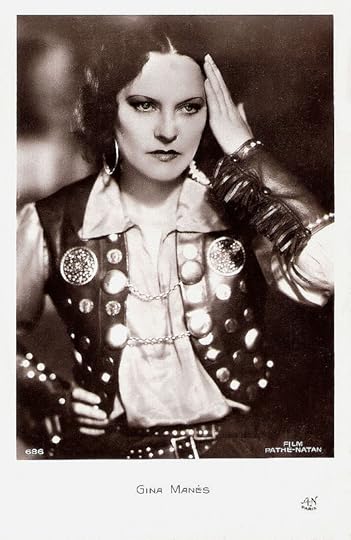
French postcard by A.N., Paris, no. 686. Photo: Film Pathé-Natan.
Photogenic
Gina Manès was born as Blanche Moulin in Paris in 1893, as the daughter of a furniture salesman.
After small roles at the Theatre du Palais Royal and other theatres, and dance performances in the revues by Rip, she was discovered by actor René Navarre . He considered her photogenic and introduced her to film director Louis Feuillade.
Changing her name to Gina Manès, she made her film debut in Les Six Petits Coeurs des Six Petites Filles/The Six hearts of Six Little Girls (Edouard-Emile Viollet, 1916).
After some more years on the stage, her film career really went off with L’Homme sans visage/Eyes Without a Face (Louis Feuillade, 1919).
She became a well-known film actress thanks to her role as the innkeeper’s daughter in L’Auberge Rouge/The Red Inn (Jean Epstein, 1923), who subsequently gave her the lead in his Coeur fidèle/The Faithful Heart (1923) both opposite Léon Mathot .
In this film Manès is a woman married to a drunken brute from whom she does not dare to separate, although she dreams of running off with a sympathetic dockworker.
Next she played an actress in a film by the avant-garde director Germaine Dulac, Ame d’artiste/Heart of an Actress (1924).
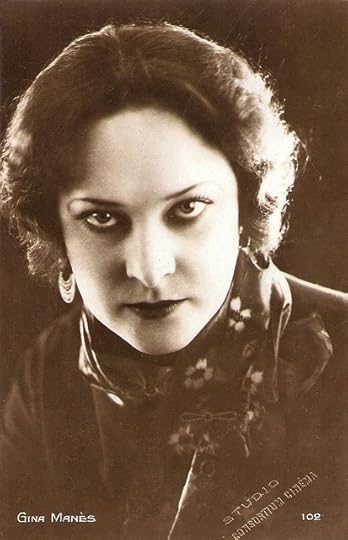
French postcard, no. 102. Studio Pathé Consortium Cinéma.
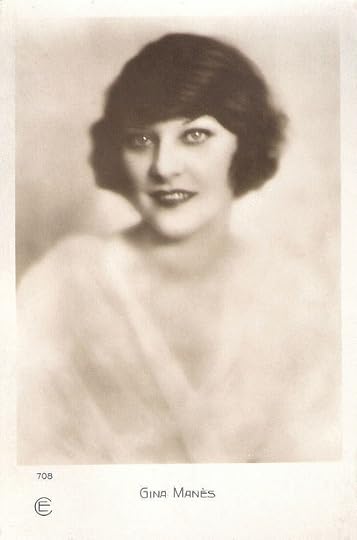
French postcard by Cinémagazine-Edition, Paris, no. 708.
The Vamp with the Emerald Eyes
Because of her troubling beauty, her heavy and poisonous look and her feline movements, Gina Manès soon became type-casted as seductress and femme fatale. Her nicknames became 'The Vamp with the Emerald Eyes', and 'The Athena with the Green Look'.
In 1927, director Abel Gance casted her as Joséphine de Beauharnais in his epic production Napoléon (1927).
Gance asked her to do a screen-test in the studio dressed only in a nightgown and jewels, Directoire styled. "I had to hum a cheerful song, then a complaining song, after which he decided that I was the perfect character for the role, as I had the historic Creole mood."
In the following year Jacques Feyder directed Manès in what is considered to be her best role, the title character in Thérèse Raquin/Shadows of Fear (1928), after the novel by Émile Zola.
The film was a Franco-German production, involving German scriptwriters, a German production manager, art direction by a Russian and a German, cinematography by a Dane and a German, and both French and German actors (including Hans Adalbert Schlettow and La Jana ).
The story deals with a truck driver (Schlettow) who kills the husband of the woman (Manès) he loves, but a blackmailer threatens to reveal the murder. Unfortunately no copy of the film remains.
In the late 1920s foreign studios called, so Manès acted in Germany and Sweden in Die Heilige und ihr Narr/The Saint and Her Fool (Wilhelm Dieterle aka William Dieterle, 1928), Die Todesschleife/Looping the loop (Arthur Robison, 1928), and Synd/Sin (Gustav Molander, 1928) with Lars Hanson .
Manès married Georges Charlia , her partner in Naples au baiser du feu/The Kiss of Fire (Serge Dadejdine, 1925) and Le trains sans yeux/Train Without Eyes (Alberto Cavalcanti, 1927).
The following years they were often coupled in films.
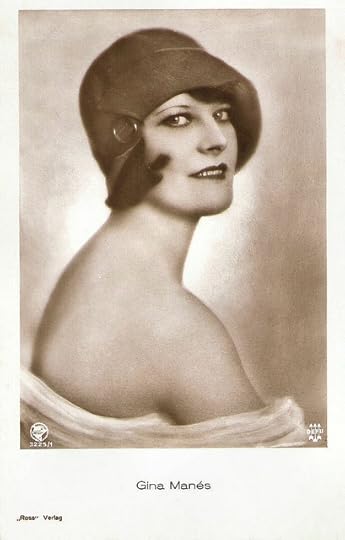
German postcard by Ross Verlag, no. 3225/1, 1928-1929. Photo: Defu (Deutsche Film-Union). This card was issued for Manès' lead in Die Heilige und ihr Narr/The Saint and Her Fool (Wilhelm Dieterle aka William Dieterle, 1928), the only film she made for Defu. She plays an envious stepmother who wants to destroy the happy marriage of her stepchild ( Lien Deyers ) with the young neighbour ( William Dieterle ).
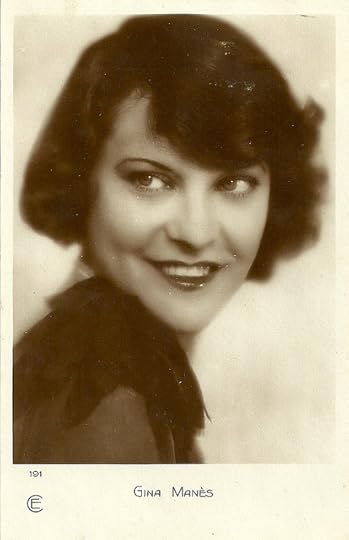
French postcard by Cinémagazine-Edition, Paris, no. 191.
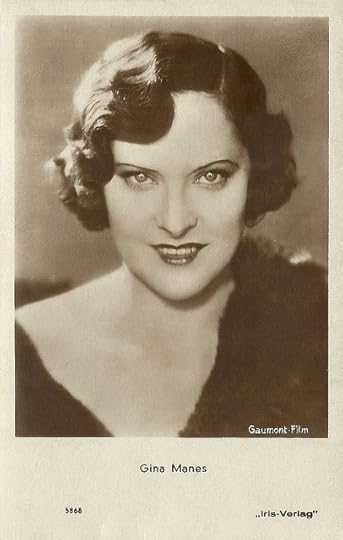
Austrian postcard by Iris-Verlag, no. 5868. Photo: Gaumont Film. Collection: Didier Hanson.
Plotting Demi-mondaines
The arrival of sound cinema did not change her status and Gina Manès continued to be a star.
She had a big commercial success in 1931 as – again – a vamp in Une belle garce/A Beautiful Bitch (Marco de Gastyne, 1930).
At the apex of her career, Manès quitted it all and with her husband Georges Charlia , she went to Morocco to open a bar on a road 100 km from Marrakech.
When she returned after two years, the film business considered her too old for being a star – she was 40 by now. Younger actresses such as Ginette Leclerc , Mireille Balin and Viviane Romance had taken over as the femme fatales of the French cinema.
Manès had to be content with secondary roles as older women still in love but neglected, such as the plotting demi-mondaine Marinka in Mayerling (Anatole Litvak, 1935) starring Charles Boyer and Danielle Darrieux .
In Les caves du Majestic/Majestic Hotel Cellars (Richard Pottier, 1944) she even became the female equivalent of Emil Jannings in Der letzte Mann/The Last Laugh (Friedrich Wilhelm Murnau, 1924): a toilet cleaner.
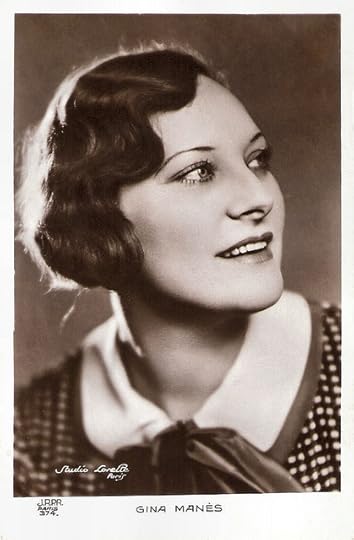
French postcard by J.R.P.R., Paris, no. 374. Photo: Studio Lorelle.
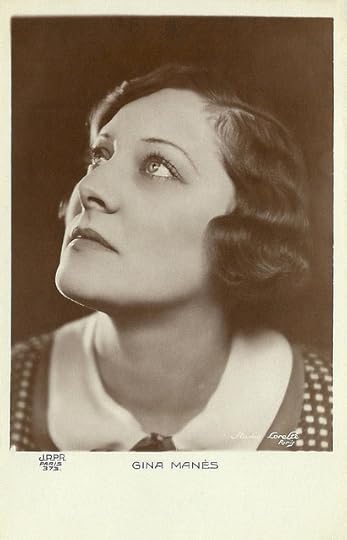
French postcard by J.R.P.R., Paris, no. 373. Photo: Studio Lorette, Paris. Collection: Didier Hanson.
Tiger Act
More and more attracted to the circus, Gina Manès started an act with tigers at the Cirque du Hiver and the Médrano. But in November 1942 she was severely wounded by a wild animal and had to retire.
After the war, while in Morocco for the shooting of La Danseuse du Marrakech/The Dancer of Marrakech ( Léon Mathot , 1949), Manès stayed there and opened up a drama course in Rabat.
She acted in two shorts, but disappointed she returned to France in 1954. Almost forgotten, she only was offered bit parts in French cinema – which she played frequently in the mid-1950s.
She turned towards the stage with the Grenier de Toulouse, where she could play parts that fit her age.
After two memorable film roles in Bonheur est pour demain/Happiness is for Tomorrow (Henri Fabiani, 1960) and Pas de panique/No Panic (Sergio Gobbi, 1966) with Pierre Brasseur , Gina Manès ended her career.
Gina Manès moved to a home in Toulouse, France, where she died in 1972, at the age of 96.
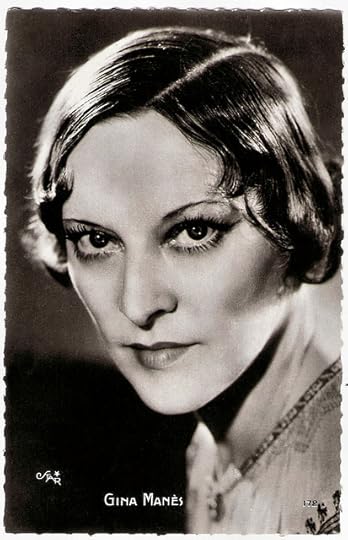
French postcard by Editions P.I., Paris, no. 172. Photo: Star.
Gina Manès sings Mois je n´dois rien à personne, the French version of Brigitte Horney 's success So oder so ist das Leben in Liebe, Tod und Teufel/Love Death and Devil (1934). The French film version is called Le diable en bouteille/The Devil in the Bottle (1935). Source: Alparfan (YouTube).
Sources: Wikipedia (English and French), and .

French postcard by A.N., Paris, no. 686. Photo: Film Pathé-Natan.
Photogenic
Gina Manès was born as Blanche Moulin in Paris in 1893, as the daughter of a furniture salesman.
After small roles at the Theatre du Palais Royal and other theatres, and dance performances in the revues by Rip, she was discovered by actor René Navarre . He considered her photogenic and introduced her to film director Louis Feuillade.
Changing her name to Gina Manès, she made her film debut in Les Six Petits Coeurs des Six Petites Filles/The Six hearts of Six Little Girls (Edouard-Emile Viollet, 1916).
After some more years on the stage, her film career really went off with L’Homme sans visage/Eyes Without a Face (Louis Feuillade, 1919).
She became a well-known film actress thanks to her role as the innkeeper’s daughter in L’Auberge Rouge/The Red Inn (Jean Epstein, 1923), who subsequently gave her the lead in his Coeur fidèle/The Faithful Heart (1923) both opposite Léon Mathot .
In this film Manès is a woman married to a drunken brute from whom she does not dare to separate, although she dreams of running off with a sympathetic dockworker.
Next she played an actress in a film by the avant-garde director Germaine Dulac, Ame d’artiste/Heart of an Actress (1924).

French postcard, no. 102. Studio Pathé Consortium Cinéma.

French postcard by Cinémagazine-Edition, Paris, no. 708.
The Vamp with the Emerald Eyes
Because of her troubling beauty, her heavy and poisonous look and her feline movements, Gina Manès soon became type-casted as seductress and femme fatale. Her nicknames became 'The Vamp with the Emerald Eyes', and 'The Athena with the Green Look'.
In 1927, director Abel Gance casted her as Joséphine de Beauharnais in his epic production Napoléon (1927).
Gance asked her to do a screen-test in the studio dressed only in a nightgown and jewels, Directoire styled. "I had to hum a cheerful song, then a complaining song, after which he decided that I was the perfect character for the role, as I had the historic Creole mood."
In the following year Jacques Feyder directed Manès in what is considered to be her best role, the title character in Thérèse Raquin/Shadows of Fear (1928), after the novel by Émile Zola.
The film was a Franco-German production, involving German scriptwriters, a German production manager, art direction by a Russian and a German, cinematography by a Dane and a German, and both French and German actors (including Hans Adalbert Schlettow and La Jana ).
The story deals with a truck driver (Schlettow) who kills the husband of the woman (Manès) he loves, but a blackmailer threatens to reveal the murder. Unfortunately no copy of the film remains.
In the late 1920s foreign studios called, so Manès acted in Germany and Sweden in Die Heilige und ihr Narr/The Saint and Her Fool (Wilhelm Dieterle aka William Dieterle, 1928), Die Todesschleife/Looping the loop (Arthur Robison, 1928), and Synd/Sin (Gustav Molander, 1928) with Lars Hanson .
Manès married Georges Charlia , her partner in Naples au baiser du feu/The Kiss of Fire (Serge Dadejdine, 1925) and Le trains sans yeux/Train Without Eyes (Alberto Cavalcanti, 1927).
The following years they were often coupled in films.

German postcard by Ross Verlag, no. 3225/1, 1928-1929. Photo: Defu (Deutsche Film-Union). This card was issued for Manès' lead in Die Heilige und ihr Narr/The Saint and Her Fool (Wilhelm Dieterle aka William Dieterle, 1928), the only film she made for Defu. She plays an envious stepmother who wants to destroy the happy marriage of her stepchild ( Lien Deyers ) with the young neighbour ( William Dieterle ).

French postcard by Cinémagazine-Edition, Paris, no. 191.

Austrian postcard by Iris-Verlag, no. 5868. Photo: Gaumont Film. Collection: Didier Hanson.
Plotting Demi-mondaines
The arrival of sound cinema did not change her status and Gina Manès continued to be a star.
She had a big commercial success in 1931 as – again – a vamp in Une belle garce/A Beautiful Bitch (Marco de Gastyne, 1930).
At the apex of her career, Manès quitted it all and with her husband Georges Charlia , she went to Morocco to open a bar on a road 100 km from Marrakech.
When she returned after two years, the film business considered her too old for being a star – she was 40 by now. Younger actresses such as Ginette Leclerc , Mireille Balin and Viviane Romance had taken over as the femme fatales of the French cinema.
Manès had to be content with secondary roles as older women still in love but neglected, such as the plotting demi-mondaine Marinka in Mayerling (Anatole Litvak, 1935) starring Charles Boyer and Danielle Darrieux .
In Les caves du Majestic/Majestic Hotel Cellars (Richard Pottier, 1944) she even became the female equivalent of Emil Jannings in Der letzte Mann/The Last Laugh (Friedrich Wilhelm Murnau, 1924): a toilet cleaner.

French postcard by J.R.P.R., Paris, no. 374. Photo: Studio Lorelle.

French postcard by J.R.P.R., Paris, no. 373. Photo: Studio Lorette, Paris. Collection: Didier Hanson.
Tiger Act
More and more attracted to the circus, Gina Manès started an act with tigers at the Cirque du Hiver and the Médrano. But in November 1942 she was severely wounded by a wild animal and had to retire.
After the war, while in Morocco for the shooting of La Danseuse du Marrakech/The Dancer of Marrakech ( Léon Mathot , 1949), Manès stayed there and opened up a drama course in Rabat.
She acted in two shorts, but disappointed she returned to France in 1954. Almost forgotten, she only was offered bit parts in French cinema – which she played frequently in the mid-1950s.
She turned towards the stage with the Grenier de Toulouse, where she could play parts that fit her age.
After two memorable film roles in Bonheur est pour demain/Happiness is for Tomorrow (Henri Fabiani, 1960) and Pas de panique/No Panic (Sergio Gobbi, 1966) with Pierre Brasseur , Gina Manès ended her career.
Gina Manès moved to a home in Toulouse, France, where she died in 1972, at the age of 96.

French postcard by Editions P.I., Paris, no. 172. Photo: Star.
Gina Manès sings Mois je n´dois rien à personne, the French version of Brigitte Horney 's success So oder so ist das Leben in Liebe, Tod und Teufel/Love Death and Devil (1934). The French film version is called Le diable en bouteille/The Devil in the Bottle (1935). Source: Alparfan (YouTube).
Sources: Wikipedia (English and French), and .
Published on November 12, 2013 23:00
November 11, 2013
Stewart Granger
English actor Stewart Granger (1913–1993) made over 60 films but is mainly associated with heroic and romantic leading roles. Tall, handsome, and athletic, Granger became England's top box office star in the Gainsborough melodramas of the 1940s. This attracted Hollywood's attention.
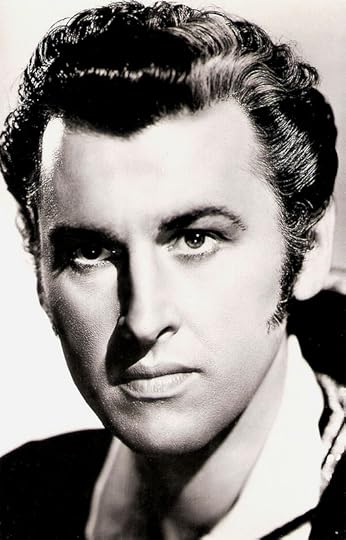
Vintage postcard.
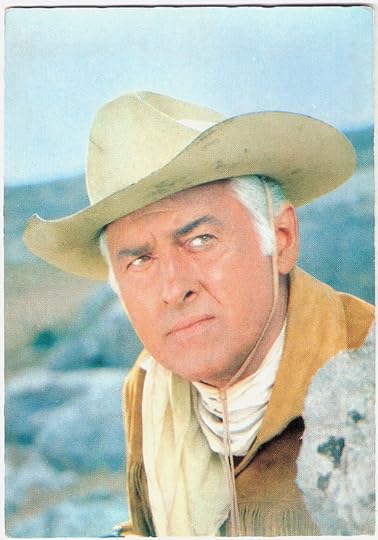
German postcard by ISV, no. C 3. Photo: Constantin. Publicity still for Unter Geiern/Among Vultures (Alfred Vohrer, 1964) with Stewart Granger as Old Surehand.
Jimmy Stewart
Stewart Granger was born as James Lablache Stewart in London in 1913 He was the only son of Major James Stewart, OBE and his wife Frederica Eliza née Lablache, and the grandson of the actor Luigi Lablache.
He was educated at Epsom College and the Webber Douglas Academy of Dramatic Art. He changed his name to avoid confusion with Hollywood star James Stewart. Granger was his Scottish grandmother's maiden name.
In 1933, he made his film debut as an extra in A Southern Maid (Harry Hughes, 1933) and by 1935 he made his stage debut in The Cardinal at Hull. He was with the Birmingham Repertory Company between 1936 and 1937, and in 1938 he made his West End debut in The Sun Never Sets.
He had been gradually rising through the ranks of better stage roles when WW II began, and he joined the British Army in 1940. However, he was eventually disabled in 1942, which brought his release from military service.
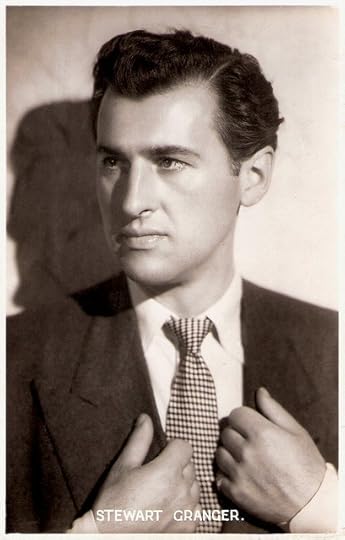
British Postcard, nr. F.S. 31. Publicity card for Saraband for Dead Lovers (Basil Dearden, 1948).
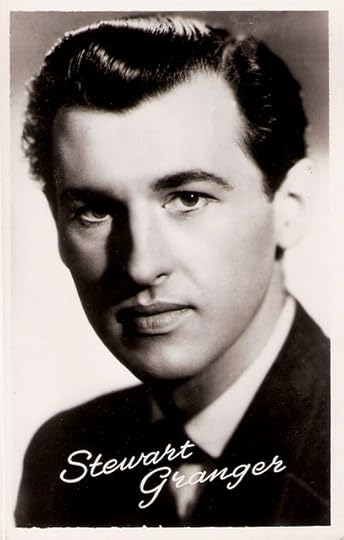
Dutch postcard by Takken, Utrecht, nr. 401.
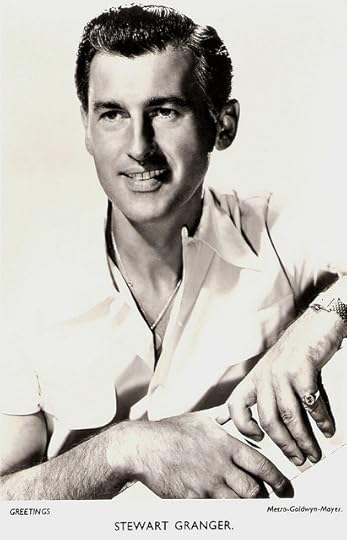
British postcard in the Greetings Series, Photo: MGM. (Metro-Goldwyn-Mayer).
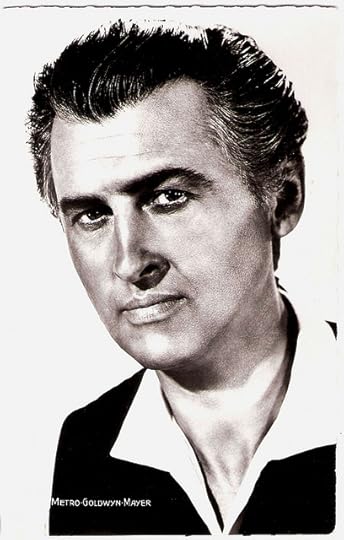
French postcard by Editions du Globe, no. 512. Photo: MGM. (Metro-Goldwyn-Mayer).
Dashing Hero Type
With a dearth of leading men for British films, Stewart Granger quickly landed The Man in Grey (Leslie Arliss, 1943). This was the first installment of Gainsborough’s successful series of costume melodramas.
His first starring role made him overnight a star in Britain. Next he starred in films like Madonna of the Seven Moons (Arthur Crabtree, 1943) with Phyllis Calvert , but the film work was unsatisfying.
He was often cast as the dashing hero type, while fellow up-and-coming actor James Mason always garnered the more substantial Gainsborough part. When Mason left for Hollywood, Granger inherited better parts in films like Caesar and Cleopatra (Gabriel Pascal, 1945) and Saraband for Dead Lovers (Basil Dearden, 1948).
Granger first met the very young Jean Simmons when they both worked on Caesar and Cleopatra (1945). Three years on, Simmons had transformed from a promising newcomer into a star - and a very attractive woman.
They married in 1950 in a bizarre wedding ceremony organised by Howard Hughes - one of his private planes flew the couple to Tucson, Arizona, where they were married, mainly among strangers, with Michael Wilding as Granger's best man. Then, Granger and Simmons both moved to Hollywood.
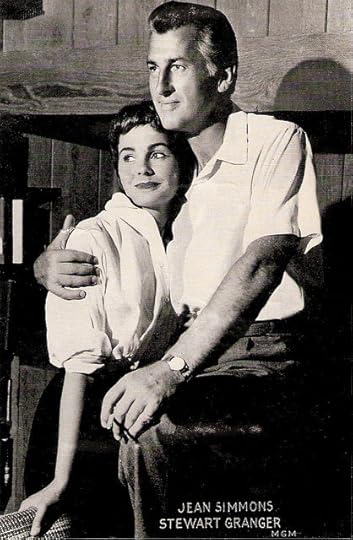
With Jean Simmons. Vintage postcard. Photo: MGM.
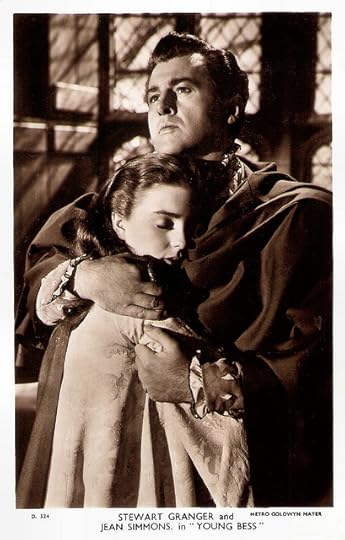
British postcard in the Picturegoer series, no. D. 324. Photo: Metro Goldwyn Mayer (MGM). Publicity still for Young Bess (George Sidney, 1953) with Jean Simmons.
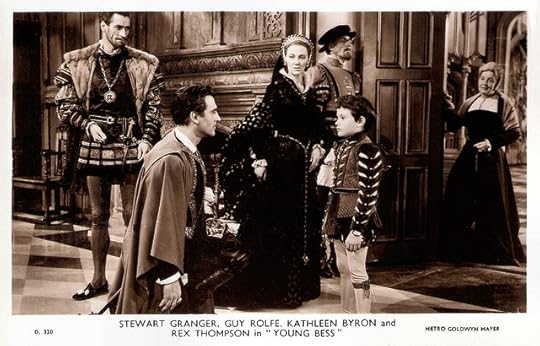
British postcard in the Picturegoer series, no. D. 320. Photo: Metro Goldwyn Mayer (MGM). Publicity still for Young Bess (George Sidney, 1953) with Guy Rolfe, Kathleen Byron, and Rex Thompson.
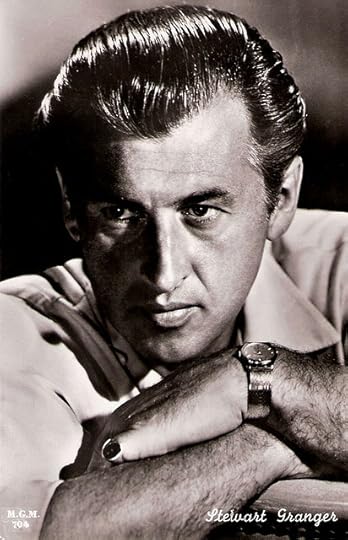
Dutch postcard by Filmphoto Service, Amsterdam, no. 704. Photo: MGM.
Swashbuckler
MGM had invited Stewart Granger to play Rider Haggard's hero Allan Quatermain in a film version of King Solomon's Mines (Compton Bennett, Andrew Morton, 1950) with Deborah Kerr . On the basis of the huge success of this film, he was offered a seven-year contract by MGM.
His theatrical voice, stature and dignified profile made him a natural heir to Errol Flynn as a swashbuckler in the popular remakes of The Prisoner of Zenda (Richard Thorpe, 1952) and Scaramouche (George Sidney, 1952), and in Moonfleet (Fritz Lang, 1955).
The audiences loved those romantic roles, but he found them still unsatisfying. He and Jean Simmons were paired in Young Bess (George Sidney, 1953), where Granger had the romantic lead, but Simmons was the focus of the movie. That sort of undeclared competition was poison to their marriage.
They also co-starred in the underrated 'Victorian' thriller, Footsteps in the Fog (Arthur Lubin, 1955). In 1960 they divorced. That year Granger starred with John Wayne in the comic western North to Alaska (Henry Hathaway, 1960). It would be the last Hollywood movie he made.
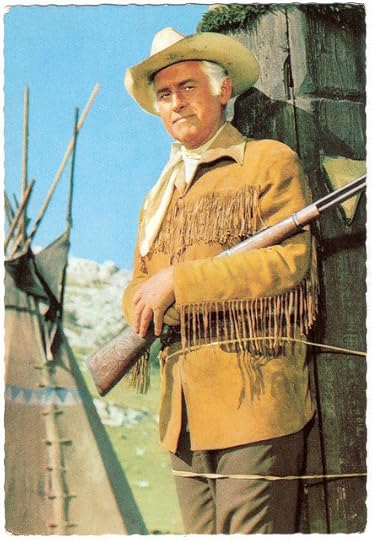
German postcard, no. 37. Photo: Constantin. Publicity still for Unter Geiern/Among Vultures (Alfred Vohrer, 1964).
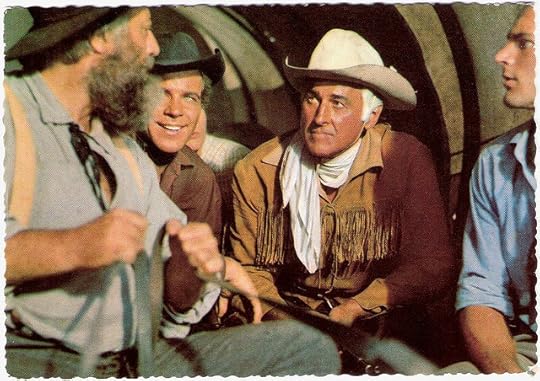
With Götz George and Mario Girotti a.o. German postcard by ISV, no. C 11. Photo: Constantin. Publicity still for Unter Geiern/Among Vultures (Alfred Vohrer, 1964).
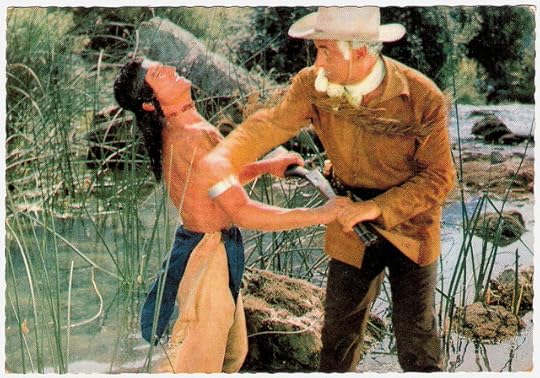
German postcard, no. 28. Photo: Constantin. Publicity still for Unter Geiern/Among Vultures (Alfred Vohrer, 1964) with Stewart Granger as Old Surehand.
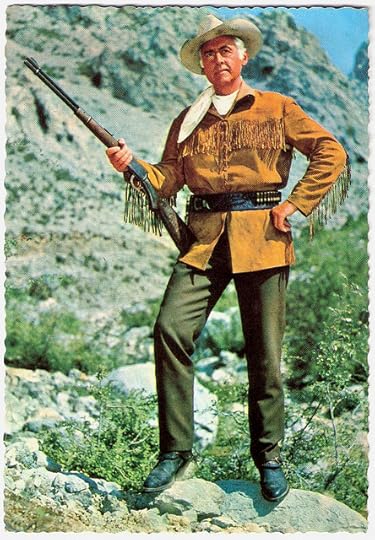
German postcard by ISV, no. C 4. Photo: Constantin. Publicity still for Unter Geiern/Among Vultures (Alfred Vohrer, 1964) with Stewart Granger as Old Surehand.
Old Surehand
In Italy, Stewart Granger appeared in a comic pastiche on The Longest Day, Il giorno più corto/The Shortest Day (Sergio Corbucci, 1962) and in another good war film Marcia o crepa/Commando (Frank Wisbar, 1962).
In Germany he played Old Surehand next to Pierre Brice ’s Winnetou in three Karl May Westerns, Unter Geiern/Among Vultures (Alfred Vohrer, 1964), Der Ölprinz/Rampage at Apache Wells (Harald Philipp, 1965) and Old Surehand/Flaming Frontier (Alfred Vohrer, 1965).
In the Edgar Wallace film series of the 1960s he was seen in The Trygon Factor (Cyril Frankel, 1966).
His film career declined in the 1970s, and he later worked mainly for American television. One of his last roles was as Prince Philip in the TV film The Royal Romance of Charles and Diana (1982). Towards the end of his career, Granger even starred in a German soap-opera called Das Erbe der Guldenburgs/The Heritage of the Guldenburgs (Jürgen Goslar, 1987).
In 1956 Stewart Granger had become a naturalized citizen of the USA, and in 1993 he died in Santa Monica from prostate cancer at the age of 80. He was married three times: to Elspeth March (1938–1948), two children, Jamie and Lindsay; to Jean Simmons (1950–1960), one daughter, Tracy; and to Caroline LeCerf (1964–1969), one daughter, Samantha.
In his autobiography Sparks fly upward (1981) he revealed that Deborah Kerr had tried to seduce him in the back of a London cab in 1950. Although they were married to others, they went on to have an affair and remained lifelong friends.
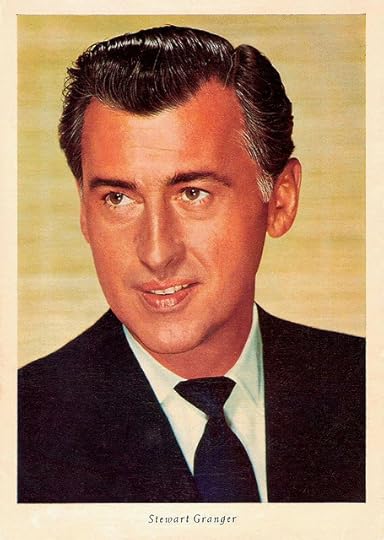
German postcard by Wilhelm Schulze-Witteborg (WS-Druck), Wanne-Eickel. Photo by Metro-Goldwyn-Mayer (MGM).
Stewart Granger and Jean Kent in a scene from Caravan (1946). Source: Parysia 77 (YouTube).
Scene from the Italian film Lo spadaccino di Siena/Swordsman of Siena (Baccio Bandini, 1962) with Sylva Koscina . Source: Henk de Vos 63 (YouTube).
Sources: Tony Williams (Encyclopedia of British Cinema), and Wikipedia.

Vintage postcard.

German postcard by ISV, no. C 3. Photo: Constantin. Publicity still for Unter Geiern/Among Vultures (Alfred Vohrer, 1964) with Stewart Granger as Old Surehand.
Jimmy Stewart
Stewart Granger was born as James Lablache Stewart in London in 1913 He was the only son of Major James Stewart, OBE and his wife Frederica Eliza née Lablache, and the grandson of the actor Luigi Lablache.
He was educated at Epsom College and the Webber Douglas Academy of Dramatic Art. He changed his name to avoid confusion with Hollywood star James Stewart. Granger was his Scottish grandmother's maiden name.
In 1933, he made his film debut as an extra in A Southern Maid (Harry Hughes, 1933) and by 1935 he made his stage debut in The Cardinal at Hull. He was with the Birmingham Repertory Company between 1936 and 1937, and in 1938 he made his West End debut in The Sun Never Sets.
He had been gradually rising through the ranks of better stage roles when WW II began, and he joined the British Army in 1940. However, he was eventually disabled in 1942, which brought his release from military service.

British Postcard, nr. F.S. 31. Publicity card for Saraband for Dead Lovers (Basil Dearden, 1948).

Dutch postcard by Takken, Utrecht, nr. 401.

British postcard in the Greetings Series, Photo: MGM. (Metro-Goldwyn-Mayer).

French postcard by Editions du Globe, no. 512. Photo: MGM. (Metro-Goldwyn-Mayer).
Dashing Hero Type
With a dearth of leading men for British films, Stewart Granger quickly landed The Man in Grey (Leslie Arliss, 1943). This was the first installment of Gainsborough’s successful series of costume melodramas.
His first starring role made him overnight a star in Britain. Next he starred in films like Madonna of the Seven Moons (Arthur Crabtree, 1943) with Phyllis Calvert , but the film work was unsatisfying.
He was often cast as the dashing hero type, while fellow up-and-coming actor James Mason always garnered the more substantial Gainsborough part. When Mason left for Hollywood, Granger inherited better parts in films like Caesar and Cleopatra (Gabriel Pascal, 1945) and Saraband for Dead Lovers (Basil Dearden, 1948).
Granger first met the very young Jean Simmons when they both worked on Caesar and Cleopatra (1945). Three years on, Simmons had transformed from a promising newcomer into a star - and a very attractive woman.
They married in 1950 in a bizarre wedding ceremony organised by Howard Hughes - one of his private planes flew the couple to Tucson, Arizona, where they were married, mainly among strangers, with Michael Wilding as Granger's best man. Then, Granger and Simmons both moved to Hollywood.

With Jean Simmons. Vintage postcard. Photo: MGM.

British postcard in the Picturegoer series, no. D. 324. Photo: Metro Goldwyn Mayer (MGM). Publicity still for Young Bess (George Sidney, 1953) with Jean Simmons.

British postcard in the Picturegoer series, no. D. 320. Photo: Metro Goldwyn Mayer (MGM). Publicity still for Young Bess (George Sidney, 1953) with Guy Rolfe, Kathleen Byron, and Rex Thompson.

Dutch postcard by Filmphoto Service, Amsterdam, no. 704. Photo: MGM.
Swashbuckler
MGM had invited Stewart Granger to play Rider Haggard's hero Allan Quatermain in a film version of King Solomon's Mines (Compton Bennett, Andrew Morton, 1950) with Deborah Kerr . On the basis of the huge success of this film, he was offered a seven-year contract by MGM.
His theatrical voice, stature and dignified profile made him a natural heir to Errol Flynn as a swashbuckler in the popular remakes of The Prisoner of Zenda (Richard Thorpe, 1952) and Scaramouche (George Sidney, 1952), and in Moonfleet (Fritz Lang, 1955).
The audiences loved those romantic roles, but he found them still unsatisfying. He and Jean Simmons were paired in Young Bess (George Sidney, 1953), where Granger had the romantic lead, but Simmons was the focus of the movie. That sort of undeclared competition was poison to their marriage.
They also co-starred in the underrated 'Victorian' thriller, Footsteps in the Fog (Arthur Lubin, 1955). In 1960 they divorced. That year Granger starred with John Wayne in the comic western North to Alaska (Henry Hathaway, 1960). It would be the last Hollywood movie he made.

German postcard, no. 37. Photo: Constantin. Publicity still for Unter Geiern/Among Vultures (Alfred Vohrer, 1964).

With Götz George and Mario Girotti a.o. German postcard by ISV, no. C 11. Photo: Constantin. Publicity still for Unter Geiern/Among Vultures (Alfred Vohrer, 1964).

German postcard, no. 28. Photo: Constantin. Publicity still for Unter Geiern/Among Vultures (Alfred Vohrer, 1964) with Stewart Granger as Old Surehand.

German postcard by ISV, no. C 4. Photo: Constantin. Publicity still for Unter Geiern/Among Vultures (Alfred Vohrer, 1964) with Stewart Granger as Old Surehand.
Old Surehand
In Italy, Stewart Granger appeared in a comic pastiche on The Longest Day, Il giorno più corto/The Shortest Day (Sergio Corbucci, 1962) and in another good war film Marcia o crepa/Commando (Frank Wisbar, 1962).
In Germany he played Old Surehand next to Pierre Brice ’s Winnetou in three Karl May Westerns, Unter Geiern/Among Vultures (Alfred Vohrer, 1964), Der Ölprinz/Rampage at Apache Wells (Harald Philipp, 1965) and Old Surehand/Flaming Frontier (Alfred Vohrer, 1965).
In the Edgar Wallace film series of the 1960s he was seen in The Trygon Factor (Cyril Frankel, 1966).
His film career declined in the 1970s, and he later worked mainly for American television. One of his last roles was as Prince Philip in the TV film The Royal Romance of Charles and Diana (1982). Towards the end of his career, Granger even starred in a German soap-opera called Das Erbe der Guldenburgs/The Heritage of the Guldenburgs (Jürgen Goslar, 1987).
In 1956 Stewart Granger had become a naturalized citizen of the USA, and in 1993 he died in Santa Monica from prostate cancer at the age of 80. He was married three times: to Elspeth March (1938–1948), two children, Jamie and Lindsay; to Jean Simmons (1950–1960), one daughter, Tracy; and to Caroline LeCerf (1964–1969), one daughter, Samantha.
In his autobiography Sparks fly upward (1981) he revealed that Deborah Kerr had tried to seduce him in the back of a London cab in 1950. Although they were married to others, they went on to have an affair and remained lifelong friends.

German postcard by Wilhelm Schulze-Witteborg (WS-Druck), Wanne-Eickel. Photo by Metro-Goldwyn-Mayer (MGM).
Stewart Granger and Jean Kent in a scene from Caravan (1946). Source: Parysia 77 (YouTube).
Scene from the Italian film Lo spadaccino di Siena/Swordsman of Siena (Baccio Bandini, 1962) with Sylva Koscina . Source: Henk de Vos 63 (YouTube).
Sources: Tony Williams (Encyclopedia of British Cinema), and Wikipedia.
Published on November 11, 2013 23:00
November 10, 2013
Robert Dinesen
Danish actor and director Robert Dinesen (1874-1972) made his film debut in Afgrunden/The Abyss (1910) as Asta Nielsen's fiancé. One year later, he directed the successful circus drama De fire djaevle/The Four Devils (1911), in which he also played the lead. It launched a trend of sensational circus drama's, and Dinesen became one of the greatest stars of the Scandinavian cinema. As a director, he had another huge hit with the orientalist melodrama Maharadjahens yndlingshustru/The Maharaja's Favourite Wife (1917) .
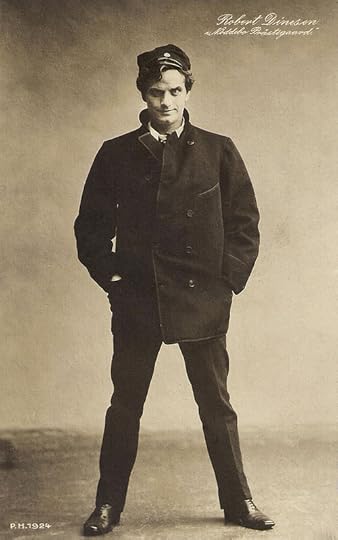
Danish postcard, no. P.H. 1924. Sent by mail in 1908. Photo: Paul Hekscher. Publicity still for the play Nödebbo Prestigaard.
Sensational Circus Drama
Robert Dinesen was born in Copenhagen, Denmark in 1874.
After being trained as a singer with William Herold and as an actor with Nicolai Neiiendam, he made his stage debut in 1894. He toured in the Nordic countries and played on several of the capital city stages, including Dagmarteatret (Dagmar Theatre).
He started his film career with the spectacular and ground-breaking Afgrunden/The Abyss (1910), as Magda's ( Asta Nielsen ) fiancé.
Already one year later, he co-directed his first film, the circus drama De fire djaevle/The Four Devils (Alexander Christian, Robert Dinesen, Alfred Lind, Carl Rosenbaum, 1911), in which he also played the lead as the wayward circus performer Fritz. The film, based on a story by Herman Bang, was an international success. The Four Devils launched a trend of sensational circus dramas. In 1928, Bang's story would be filmed again in Hollywood by legendary director F.W. Murnau.
Kinografen, the production company of De fire djaevle/The Four Devils built a large studio to expand, but to no avail.
Dinesen moved over to Nordisk, the biggest Danish film studio then.
From 1912 on, Robert Dinesen alternated playing in various Nordisk films by directors such as August Blom and Eduard Schnedler-Sorensen with making his own films, also at Nordisk. In 1913 he assisted Blom in directing his prestigious film drama Atlantis (August Blom, 1913).
All in all he acted in and directed some 70 films at Nordisk, working with such actors as Valdemar Psilander , Betty Nansen and Gunnar Tolnaes .
His biggest success was the orientalist melodrama Maharadjahens yndlingshustru/The Maharaja's Favourite Wife (Robert Dinesen, 1917) with Gunnar Tolnaes as an Indian prince and Lilly Jacobson as his love interest, the Danish Elly von Langen. The film was so popular that it had a Danish companion piece in 1919, again with Tolnaes and Jacobson, and a German sequel in 1921.
Robert Dinesen also produced such films as the sensationalistic series Gar el Hama (1911-1914) and Jefthas Dotter/Jephta's Daughter (1919), a Swedish production by Palladium.
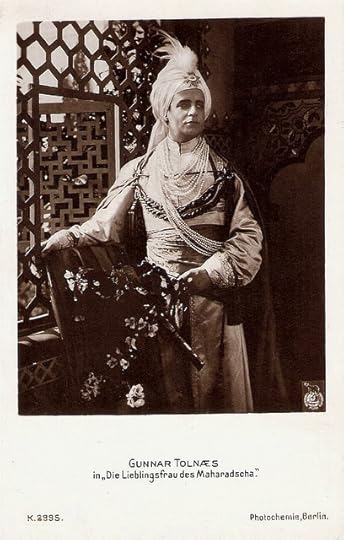
German postcard by Photochemie, Berlin, no. K 2995. Photo: Nordisk. Publicity still for Maharadjahens yndlingshustru/The Maharaja's Favourite Wife (Robert Dinesen, 1917) with Gunnar Tolnaes .
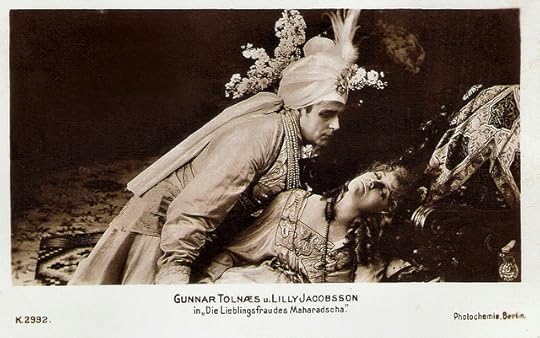
German postcard by Photochemie, Berlin, no. K.2992. Photo: Nordisk. Publicity still for Maharadjahens yndlingshustru/The Maharaja's Favourite Wife (Robert Dinesen, 1917) with Gunnar Tolnaes and Lilly Jacobson .
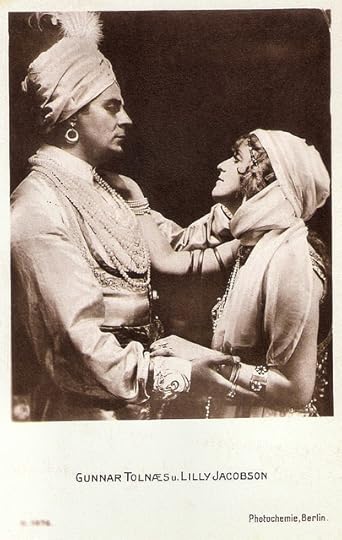
German postcard by Photochemie, Berlin. Photo: Nordisk. Publicity still for Maharadjahens yndlingshustru/The Maharaja's Favourite Wife (Robert Dinesen, 1917) with Gunnar Tolnaes and Lilly Jacobson .
Lya de Putti
Robert Dinesen married German actress Margaretha Schön (his third wife), and he moved to Berlin.
Producer Joe May invited him to co-direct with him Die Frauen von Gnadestein/The Women of Gnadestein (1920). In the 1920s, while working for May-Film, Ufa and Phoebus, Dinesen directed some 25 films.
In several of his films starred Lya de Putti . These productions included Ilona (1921), Thamar, das Kind der Berge/Thamar, the Child of the Mountains (1924), Malva (1924), Claire (1924), and Im Namen des Kaisers/In the Name of the Kaiser (1925). Most of them were made shortly before her international breakthrough with Varieté/Variety (E.A. Dupont, 1925).
In 1922 Dinesen made one more film for the Swedish company Palladium, Odets reskap.
His last film was Der Weg durch die Nacht/The Way Through the Night (1929) starring Käthe von Nagy, and his wife Margarethe Schön.
Dinesen refused to work for Joseph Goebbels, neither as an actor nor director, and retired, dedicating his time to painting. His wife Margarethe continued acting after 1933, and did some 24 films until 1945.
Robert Dinesen remained in Berlin (later West-Berlin), but he returned to Copenhagen shortly before his death in 1972 at the age of 97. He had been married with the actresses Marie Dinesen, Johanne Dinesen and Margarethe Schön.
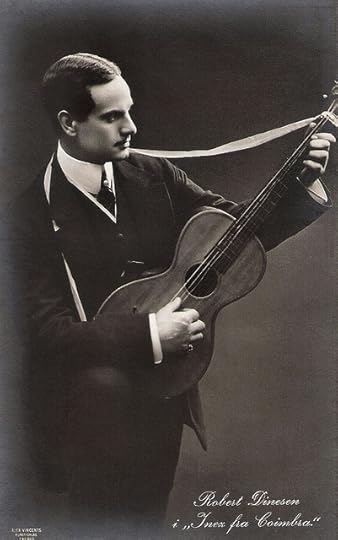
Danish postcard by Alex. Vincent's Kunstforlag. Eneret, no. 709. The title Inez fra Coimbra lacks in databases such as IMDb and the one of the Danish Film Institute . There was a musical play with this title, composed by Danish composer Adolph Julius Eggers. It was based on Portuguese folk music. The piece was edited as sheet music in 1908.
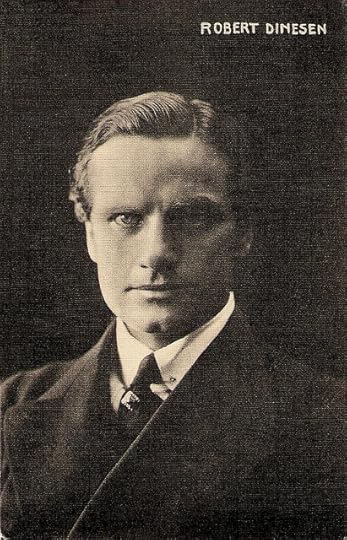
Austrian postcard by Projectograph Aktiengesellschaft, Wien (Vienna). Photo: Nordisk Films Co., Kopenhagen.
Sources: Hans J. Wollstein (AllMovie), Det Danske Filminstitut (Danish) and .

Danish postcard, no. P.H. 1924. Sent by mail in 1908. Photo: Paul Hekscher. Publicity still for the play Nödebbo Prestigaard.
Sensational Circus Drama
Robert Dinesen was born in Copenhagen, Denmark in 1874.
After being trained as a singer with William Herold and as an actor with Nicolai Neiiendam, he made his stage debut in 1894. He toured in the Nordic countries and played on several of the capital city stages, including Dagmarteatret (Dagmar Theatre).
He started his film career with the spectacular and ground-breaking Afgrunden/The Abyss (1910), as Magda's ( Asta Nielsen ) fiancé.
Already one year later, he co-directed his first film, the circus drama De fire djaevle/The Four Devils (Alexander Christian, Robert Dinesen, Alfred Lind, Carl Rosenbaum, 1911), in which he also played the lead as the wayward circus performer Fritz. The film, based on a story by Herman Bang, was an international success. The Four Devils launched a trend of sensational circus dramas. In 1928, Bang's story would be filmed again in Hollywood by legendary director F.W. Murnau.
Kinografen, the production company of De fire djaevle/The Four Devils built a large studio to expand, but to no avail.
Dinesen moved over to Nordisk, the biggest Danish film studio then.
From 1912 on, Robert Dinesen alternated playing in various Nordisk films by directors such as August Blom and Eduard Schnedler-Sorensen with making his own films, also at Nordisk. In 1913 he assisted Blom in directing his prestigious film drama Atlantis (August Blom, 1913).
All in all he acted in and directed some 70 films at Nordisk, working with such actors as Valdemar Psilander , Betty Nansen and Gunnar Tolnaes .
His biggest success was the orientalist melodrama Maharadjahens yndlingshustru/The Maharaja's Favourite Wife (Robert Dinesen, 1917) with Gunnar Tolnaes as an Indian prince and Lilly Jacobson as his love interest, the Danish Elly von Langen. The film was so popular that it had a Danish companion piece in 1919, again with Tolnaes and Jacobson, and a German sequel in 1921.
Robert Dinesen also produced such films as the sensationalistic series Gar el Hama (1911-1914) and Jefthas Dotter/Jephta's Daughter (1919), a Swedish production by Palladium.

German postcard by Photochemie, Berlin, no. K 2995. Photo: Nordisk. Publicity still for Maharadjahens yndlingshustru/The Maharaja's Favourite Wife (Robert Dinesen, 1917) with Gunnar Tolnaes .

German postcard by Photochemie, Berlin, no. K.2992. Photo: Nordisk. Publicity still for Maharadjahens yndlingshustru/The Maharaja's Favourite Wife (Robert Dinesen, 1917) with Gunnar Tolnaes and Lilly Jacobson .

German postcard by Photochemie, Berlin. Photo: Nordisk. Publicity still for Maharadjahens yndlingshustru/The Maharaja's Favourite Wife (Robert Dinesen, 1917) with Gunnar Tolnaes and Lilly Jacobson .
Lya de Putti
Robert Dinesen married German actress Margaretha Schön (his third wife), and he moved to Berlin.
Producer Joe May invited him to co-direct with him Die Frauen von Gnadestein/The Women of Gnadestein (1920). In the 1920s, while working for May-Film, Ufa and Phoebus, Dinesen directed some 25 films.
In several of his films starred Lya de Putti . These productions included Ilona (1921), Thamar, das Kind der Berge/Thamar, the Child of the Mountains (1924), Malva (1924), Claire (1924), and Im Namen des Kaisers/In the Name of the Kaiser (1925). Most of them were made shortly before her international breakthrough with Varieté/Variety (E.A. Dupont, 1925).
In 1922 Dinesen made one more film for the Swedish company Palladium, Odets reskap.
His last film was Der Weg durch die Nacht/The Way Through the Night (1929) starring Käthe von Nagy, and his wife Margarethe Schön.
Dinesen refused to work for Joseph Goebbels, neither as an actor nor director, and retired, dedicating his time to painting. His wife Margarethe continued acting after 1933, and did some 24 films until 1945.
Robert Dinesen remained in Berlin (later West-Berlin), but he returned to Copenhagen shortly before his death in 1972 at the age of 97. He had been married with the actresses Marie Dinesen, Johanne Dinesen and Margarethe Schön.

Danish postcard by Alex. Vincent's Kunstforlag. Eneret, no. 709. The title Inez fra Coimbra lacks in databases such as IMDb and the one of the Danish Film Institute . There was a musical play with this title, composed by Danish composer Adolph Julius Eggers. It was based on Portuguese folk music. The piece was edited as sheet music in 1908.

Austrian postcard by Projectograph Aktiengesellschaft, Wien (Vienna). Photo: Nordisk Films Co., Kopenhagen.
Sources: Hans J. Wollstein (AllMovie), Det Danske Filminstitut (Danish) and .
Published on November 10, 2013 23:00
November 9, 2013
Hans von Borsody (1929-2013)
German film, TV and stage actor Hans von Borsody (1929-2013) died Monday, 4 November, at his home in Kiel, Germany. During his decades-long career, he was seen in the war drama A Bridge Too Far (1977) and many other films. On stage, he starred as Faust and Cyrano de Bergerac. Borsody was 84 years old.
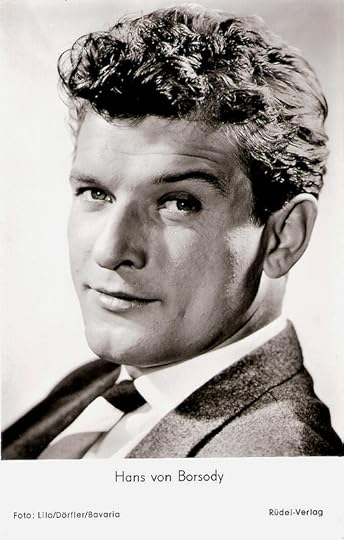
German postcard by Franz Josef Rüdel, Filmpostkartenverlag, Hamburg-Bergedorf, no. 2657. Photo: Lilo / Dörfler /Bavaria.
Jeune Premier
Hans Eduard Herbert von Borsody was born in Vienna, Austria in 1929.
His parents were the film director Eduard von Borsody and the concert pianist and violinist Maria Hochreiter. When Borsody was three, his family moved to Berlin and obtained German citizenship.
Von Borsody came early into contact with the film business, but at his father's request, he started a photography study.
From 1950 to 1952, he studied acting at the Max-Reinhardt-Seminar in Vienna. Later he stood on stage in many German and Austrian cities such as Munich, Vienna, Frankfurt, Dusseldorf, Berlin and Hamburg.
He made his film debut in Don Giovanni/Don Juan (Walter Kolm-Veltée, 1955) featuring Cesare Danova. This musical swashbuckler follows closely the plot of Mozart's opera Don Giovanni.
Thanks to his roles as a jeune premier in films like the Heimatfilm Der Schandfleck/The Disgrace (Herbert B. Fredersdorf, 1956), Hans von Borsody quickly made a name.
He starred in the crime thriller Das Rätsel der grünen Spinne/The Mystery of the Green Spider (Franz Marischka 1960) and the Austrian drama Sturm am Wilden Kaiser/Mountain wind (1963), written and directed by his father Eduard von Borsody.
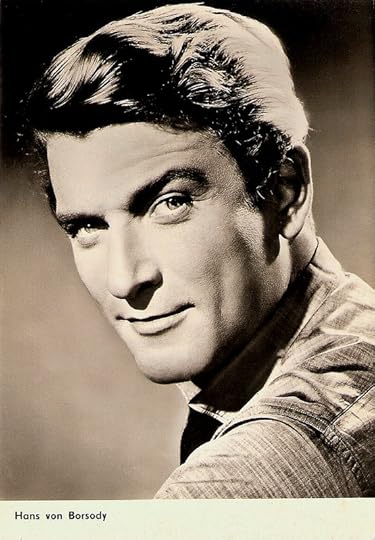
East-German postcard by VEB Progress Filmvertrieb, Berlin, no. 2204, 1964. Retail price 0.20 DM.
Stylish, Flamboyant Giallo-Thriller
During the 1960s, Hans von Borsody played in several pan-European co-productions.
He had supporting parts in the war films Marcia o crepa/Commando (Frank Wisbar, 1962), set during the Algerian War and starring Stewart Granger , and Sette contro la morte/The Cavern (Edgar G. Ulmer, 1964) with John Saxon. The latter is a claustrophobic WW II war drama, which chronicles the five months which six soldiers and one woman spent trapped within a deep cave in the Italian mountains.
He rode as a cowboy across the prairie in the Italian Spaghetti Western Buffalo Bill, l'eroe del far west/Buffalo Bill, Hero of the Far West (Mario Costa, 1965) featuring Gordon Scott.
In Germany, he played as Volker von Alzey in the two-part epic sword-and-sorcery fantasy Die Nibelungen (Harald Reinl, 1966-1967), a remake of the silent classic directed by Fritz Lang in 1924.
He became a household name in the German speaking countries as detective Cliff Dexter in the Krimi series Cliff Dexter (1966-1968), which kept millions of European TV viewers spellbound.
In Italy, he also appeared in Omicidio per appuntamento/Date for a Murder (Mino Guerrini, 1966). At AllMovie , Robert Firsching describes the film as a "stylish, flamboyant giallo-thriller clearly influenced by the striking work of genre pioneer Mario Bava".
Von Borsody fought as a rebel against the Romans in Hermann der Cherusker - Die Schlacht im Teutoburger Wald/Massacre in the Black Forest (Ferdinando Baldi, Rudolf Nussgruber, 1967), a historical drama film set in the German frontier in AD 9.
The film centers on Hermann, a chieftain of the Cherusci tribe (in what is now Hesse), who drew three Roman legions into an ambush in the Teutoburg Forest, known as the Battle of the Teutoburg Forest. His co-stars were Antonella Lualdi and Cameron Mitchell.
Scene from Omicidio per appuntamento/Date for a Murder (Mino Guerrini, 1966). Source: Роман Мацнев (YouTube).
His Role of a Lifetime
During the 1970s and 1980s, Hans von Borsody played in several German TV films and series and in a few international films.
Among these films were the war epic A Bridge Too Far ( Richard Attenborough , 1977) and the thriller Bloodline (Terence Young, 1979), based upon the novel by Sidney Sheldon, and starring Audrey Hepburn .
His role of a lifetime was Cyrano de Bergerac, which Von Borsody performed on stage in Vienna and Andernach. It was the role about which he had already dreamed during his studies at the Max-Reinhardt-Seminar.
Hans von Borsody died in Kiel, Germany in 2013. He was 84.
He is survived by his fourth wife Karin and his daughters Suzanne and Cosima. After his first marriage with actress Rosemarie Fendel ended, he was married to actresses Alwy Becker and Heide Keller.
Suzanne von Borsody, his daughter with Rosemarie Fendel, is an award winning actress. Her half-sister Cosima von Borsody, his daughter with Alwy Becker, also works for the camera.
Trailer for Die Nibelungen - Teil II: Kriemhilds Rache (Harald Reinl, 1967). Source: R6dw6C (YouTube).
Sources: Robert Firsching (AllMovie), T Online (German), AllMovie, Wikipedia (German and English), and

German postcard by Franz Josef Rüdel, Filmpostkartenverlag, Hamburg-Bergedorf, no. 2657. Photo: Lilo / Dörfler /Bavaria.
Jeune Premier
Hans Eduard Herbert von Borsody was born in Vienna, Austria in 1929.
His parents were the film director Eduard von Borsody and the concert pianist and violinist Maria Hochreiter. When Borsody was three, his family moved to Berlin and obtained German citizenship.
Von Borsody came early into contact with the film business, but at his father's request, he started a photography study.
From 1950 to 1952, he studied acting at the Max-Reinhardt-Seminar in Vienna. Later he stood on stage in many German and Austrian cities such as Munich, Vienna, Frankfurt, Dusseldorf, Berlin and Hamburg.
He made his film debut in Don Giovanni/Don Juan (Walter Kolm-Veltée, 1955) featuring Cesare Danova. This musical swashbuckler follows closely the plot of Mozart's opera Don Giovanni.
Thanks to his roles as a jeune premier in films like the Heimatfilm Der Schandfleck/The Disgrace (Herbert B. Fredersdorf, 1956), Hans von Borsody quickly made a name.
He starred in the crime thriller Das Rätsel der grünen Spinne/The Mystery of the Green Spider (Franz Marischka 1960) and the Austrian drama Sturm am Wilden Kaiser/Mountain wind (1963), written and directed by his father Eduard von Borsody.

East-German postcard by VEB Progress Filmvertrieb, Berlin, no. 2204, 1964. Retail price 0.20 DM.
Stylish, Flamboyant Giallo-Thriller
During the 1960s, Hans von Borsody played in several pan-European co-productions.
He had supporting parts in the war films Marcia o crepa/Commando (Frank Wisbar, 1962), set during the Algerian War and starring Stewart Granger , and Sette contro la morte/The Cavern (Edgar G. Ulmer, 1964) with John Saxon. The latter is a claustrophobic WW II war drama, which chronicles the five months which six soldiers and one woman spent trapped within a deep cave in the Italian mountains.
He rode as a cowboy across the prairie in the Italian Spaghetti Western Buffalo Bill, l'eroe del far west/Buffalo Bill, Hero of the Far West (Mario Costa, 1965) featuring Gordon Scott.
In Germany, he played as Volker von Alzey in the two-part epic sword-and-sorcery fantasy Die Nibelungen (Harald Reinl, 1966-1967), a remake of the silent classic directed by Fritz Lang in 1924.
He became a household name in the German speaking countries as detective Cliff Dexter in the Krimi series Cliff Dexter (1966-1968), which kept millions of European TV viewers spellbound.
In Italy, he also appeared in Omicidio per appuntamento/Date for a Murder (Mino Guerrini, 1966). At AllMovie , Robert Firsching describes the film as a "stylish, flamboyant giallo-thriller clearly influenced by the striking work of genre pioneer Mario Bava".
Von Borsody fought as a rebel against the Romans in Hermann der Cherusker - Die Schlacht im Teutoburger Wald/Massacre in the Black Forest (Ferdinando Baldi, Rudolf Nussgruber, 1967), a historical drama film set in the German frontier in AD 9.
The film centers on Hermann, a chieftain of the Cherusci tribe (in what is now Hesse), who drew three Roman legions into an ambush in the Teutoburg Forest, known as the Battle of the Teutoburg Forest. His co-stars were Antonella Lualdi and Cameron Mitchell.
Scene from Omicidio per appuntamento/Date for a Murder (Mino Guerrini, 1966). Source: Роман Мацнев (YouTube).
His Role of a Lifetime
During the 1970s and 1980s, Hans von Borsody played in several German TV films and series and in a few international films.
Among these films were the war epic A Bridge Too Far ( Richard Attenborough , 1977) and the thriller Bloodline (Terence Young, 1979), based upon the novel by Sidney Sheldon, and starring Audrey Hepburn .
His role of a lifetime was Cyrano de Bergerac, which Von Borsody performed on stage in Vienna and Andernach. It was the role about which he had already dreamed during his studies at the Max-Reinhardt-Seminar.
Hans von Borsody died in Kiel, Germany in 2013. He was 84.
He is survived by his fourth wife Karin and his daughters Suzanne and Cosima. After his first marriage with actress Rosemarie Fendel ended, he was married to actresses Alwy Becker and Heide Keller.
Suzanne von Borsody, his daughter with Rosemarie Fendel, is an award winning actress. Her half-sister Cosima von Borsody, his daughter with Alwy Becker, also works for the camera.
Trailer for Die Nibelungen - Teil II: Kriemhilds Rache (Harald Reinl, 1967). Source: R6dw6C (YouTube).
Sources: Robert Firsching (AllMovie), T Online (German), AllMovie, Wikipedia (German and English), and
Published on November 09, 2013 23:00
November 8, 2013
Verdun, visions d'histoire (1928)
In two months it will be 2014 and it will be 100 years ago that the First World War started.
European Film Gateway 1914
is an interesting digitisation project focusing on films and non-film material from and related to World War I. 26 partners, among them 21 European film archives, are digitalising 661 hours of film and ca. 5.600 film-related documents on the theme of the First World War. And it's all free accessible, so check it out.
The French silent film Verdun, visions d'histoire (Léon Poirier, 1928) is a dramatized account of the Battle of Verdun (1916), a key World War I battle. French troops, fighting alone and often in desperate hand-to-hand combat, had to halt the German advance at all costs. The film uses newsreel footage, director Léon Poirier's own highly realistic reconstructions of the conflict and some little dramatic scenes which add a thread of personal interest to the events. On European Film Gateway 1914, there is only a poster of Verdun, visions d'histoire yet. Here at EFSP, we present you the postcards.
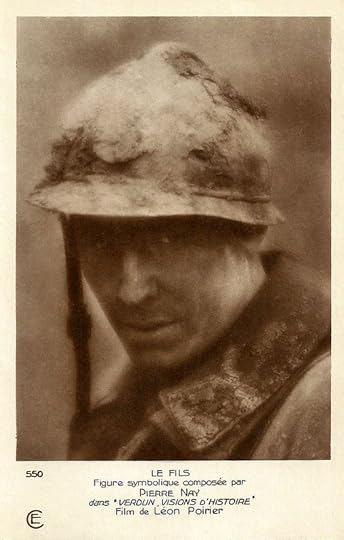
French postcard by Editions Cinémagazine, no. 550. Photo: Pierre Nay as The Son in Verdun, visions d'histoire (Léon Poirier, 1928).
Crawling Across No-man's-land
Director Léon Poirier tells Verdun, visions d'histoire from both sides. The film is surprisingly sympathetic to the German point of view, considering when it was made.
Poirier's pacifist stance is revealed in several moments, notably in one scene when two angels descend onto the battlefield and extract the souls of two soldiers, one German and one French, and place them together on a stretcher which they carry up to heaven.
The re-enacted battle sequences, place the viewer in the midst of the horror, crawling across no-man's-land, cowering in fox-holes, or being blown apart in trenches. The countryside is shown as a moonscape of craters and splintered trees.
The film features newly filmed material, but also features much archive footage of Emperor Wilhelm II and German marches. It also features maps to illustrate the battle.
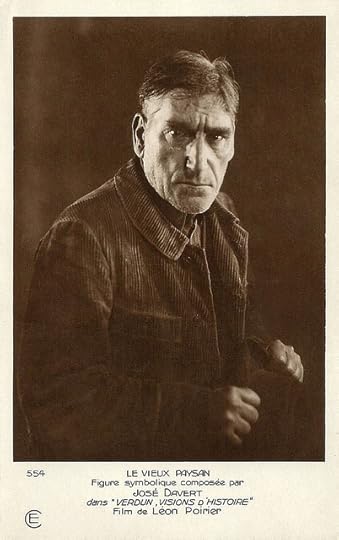
French postcard by Editions Cinémagazine, no. 554. Photo: José Davert as The Old Farmer in Verdun, visions d'histoire (Léon Poirier, 1928).
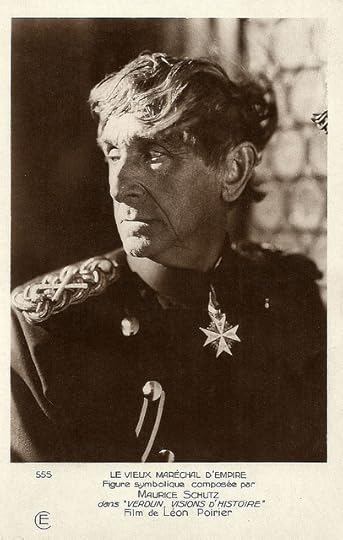
French postcard by Editions Cinémagazine, no. 555. Photo: publicity still of Maurice Schutz as The Old Marshal in Verdun, visions d'histoire (Léon Poirier, 1928).
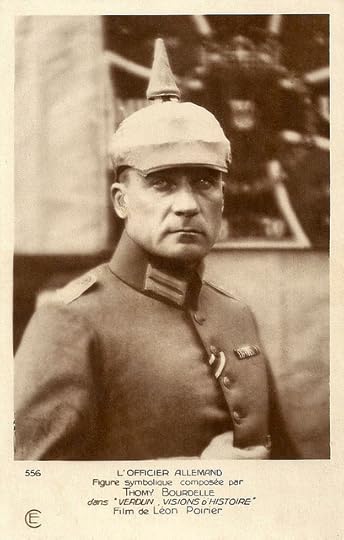
French postcard by Editions Cinemagazine, no. 556. Photo: Thomy Bourdelle as The German officer in Verdun, visions d'histoire (Léon Poirier, 1928).

French postcard by A.N., Paris, no. 344. Photo: Alban. Suzanne Bianchetti as The Wife in Verdun, visions d'histoire (Léon Poirier, 1928).
Filmed In A Real Shell Hole
Verdun, visions d'histoire is filmed on location in Verdun and surroundings. The scene in which the Intellectual (Antonin Artaud) dies, is actually filmed in a real shell hole. Remains of a human arm were found with a ID tag on which the filmmakers could just make out: "Fulle... 1916" (Class of 1916).
For the Bois des Caures scene many actual veterans are used. Among them are Lieutenant Robin and captain Vantroys, who responded to Léon Poirier's call to participate in the film. They are playing themselves in the film.
According to Poirier, the entire cast and crew of the film were made up of Great War veterans. The only exceptions were the female actresses, like Suzanne Bianchetti and Jeanne Marie-Laurent, and the older actors such as André Nox and Maurice Schutz . Antonin Artaud also wasn't a veteran.
The premiere of the film took place in Paris in November 1928, at the Opéra Garnier, to celebrate the 10 years of the armistice.
In 1931, a re-edited sound version of Verdun, souvenirs d'histoire was released with some re-shot scenes using different actors.
Many prints of the film were lost over the years and only very few prints were available. the best existing print was found in Moscow: stolen from France by the Nazis, then grabbed by the Russians at the end of the war. A restoration by the Cinémathèque de Toulouse of this print of the original silent version was issued on DVD in 2006.
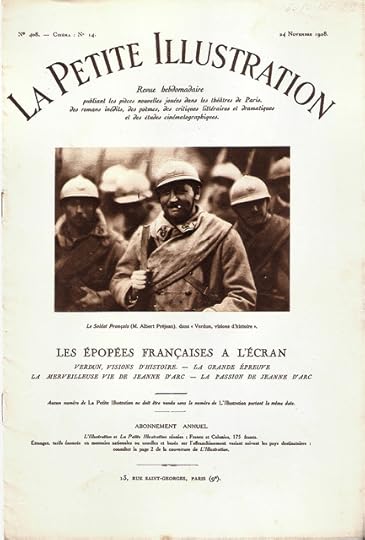
Cover of the French magazine La Petite Illustration, no. 408, 18 September 1928. The picture shows Albert Préjean in the film Verdun, visions d'histoire (Léon Poirier, 1928).
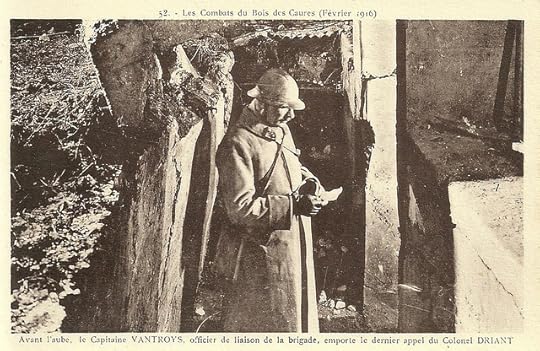
French postcard by Editions V.G., no. 32. Verdun, visions d'histoire (Léon Poirier, 1928) was released a decade after the end of the First World War.
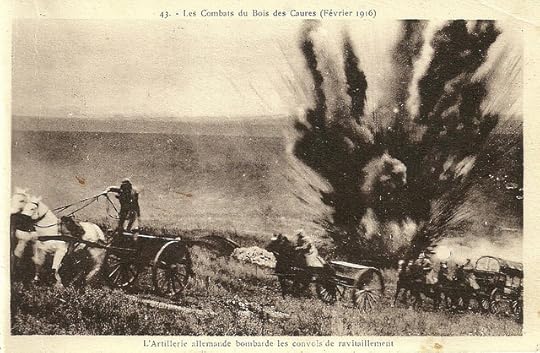
French postcard by Editions V.G., no. 43.
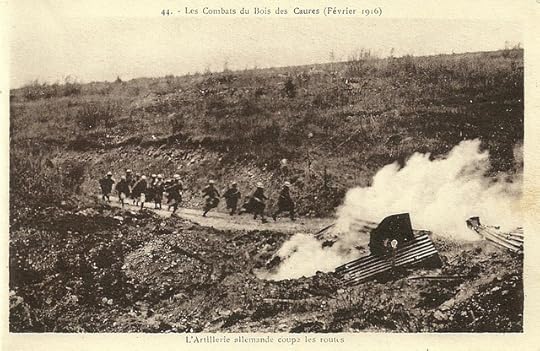
French postcard by Editions V.G., no. 44.
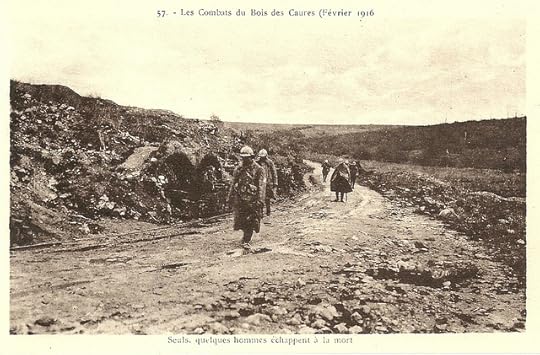
French postcard by Editions V.G., no. 37.
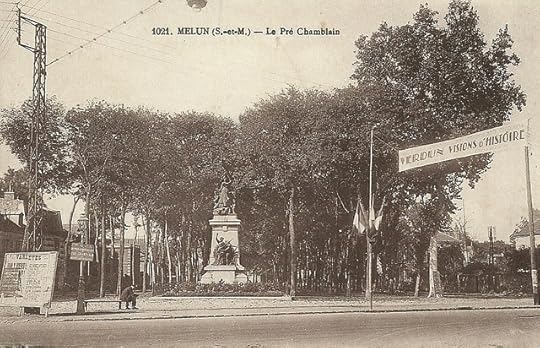
French postcard by Photo-Edit. E. Mignon, Nangis, Seine-et-Marne, no. 1021. The film Verdun, visions d'histoire (Léon Poirier, 1928) shown in Melun (Seine et Marne district), which is some 50 km from Paris.
Sources: Wikipedia (French) and IMDb.
The French silent film Verdun, visions d'histoire (Léon Poirier, 1928) is a dramatized account of the Battle of Verdun (1916), a key World War I battle. French troops, fighting alone and often in desperate hand-to-hand combat, had to halt the German advance at all costs. The film uses newsreel footage, director Léon Poirier's own highly realistic reconstructions of the conflict and some little dramatic scenes which add a thread of personal interest to the events. On European Film Gateway 1914, there is only a poster of Verdun, visions d'histoire yet. Here at EFSP, we present you the postcards.

French postcard by Editions Cinémagazine, no. 550. Photo: Pierre Nay as The Son in Verdun, visions d'histoire (Léon Poirier, 1928).
Crawling Across No-man's-land
Director Léon Poirier tells Verdun, visions d'histoire from both sides. The film is surprisingly sympathetic to the German point of view, considering when it was made.
Poirier's pacifist stance is revealed in several moments, notably in one scene when two angels descend onto the battlefield and extract the souls of two soldiers, one German and one French, and place them together on a stretcher which they carry up to heaven.
The re-enacted battle sequences, place the viewer in the midst of the horror, crawling across no-man's-land, cowering in fox-holes, or being blown apart in trenches. The countryside is shown as a moonscape of craters and splintered trees.
The film features newly filmed material, but also features much archive footage of Emperor Wilhelm II and German marches. It also features maps to illustrate the battle.

French postcard by Editions Cinémagazine, no. 554. Photo: José Davert as The Old Farmer in Verdun, visions d'histoire (Léon Poirier, 1928).

French postcard by Editions Cinémagazine, no. 555. Photo: publicity still of Maurice Schutz as The Old Marshal in Verdun, visions d'histoire (Léon Poirier, 1928).

French postcard by Editions Cinemagazine, no. 556. Photo: Thomy Bourdelle as The German officer in Verdun, visions d'histoire (Léon Poirier, 1928).

French postcard by A.N., Paris, no. 344. Photo: Alban. Suzanne Bianchetti as The Wife in Verdun, visions d'histoire (Léon Poirier, 1928).
Filmed In A Real Shell Hole
Verdun, visions d'histoire is filmed on location in Verdun and surroundings. The scene in which the Intellectual (Antonin Artaud) dies, is actually filmed in a real shell hole. Remains of a human arm were found with a ID tag on which the filmmakers could just make out: "Fulle... 1916" (Class of 1916).
For the Bois des Caures scene many actual veterans are used. Among them are Lieutenant Robin and captain Vantroys, who responded to Léon Poirier's call to participate in the film. They are playing themselves in the film.
According to Poirier, the entire cast and crew of the film were made up of Great War veterans. The only exceptions were the female actresses, like Suzanne Bianchetti and Jeanne Marie-Laurent, and the older actors such as André Nox and Maurice Schutz . Antonin Artaud also wasn't a veteran.
The premiere of the film took place in Paris in November 1928, at the Opéra Garnier, to celebrate the 10 years of the armistice.
In 1931, a re-edited sound version of Verdun, souvenirs d'histoire was released with some re-shot scenes using different actors.
Many prints of the film were lost over the years and only very few prints were available. the best existing print was found in Moscow: stolen from France by the Nazis, then grabbed by the Russians at the end of the war. A restoration by the Cinémathèque de Toulouse of this print of the original silent version was issued on DVD in 2006.

Cover of the French magazine La Petite Illustration, no. 408, 18 September 1928. The picture shows Albert Préjean in the film Verdun, visions d'histoire (Léon Poirier, 1928).

French postcard by Editions V.G., no. 32. Verdun, visions d'histoire (Léon Poirier, 1928) was released a decade after the end of the First World War.

French postcard by Editions V.G., no. 43.

French postcard by Editions V.G., no. 44.

French postcard by Editions V.G., no. 37.

French postcard by Photo-Edit. E. Mignon, Nangis, Seine-et-Marne, no. 1021. The film Verdun, visions d'histoire (Léon Poirier, 1928) shown in Melun (Seine et Marne district), which is some 50 km from Paris.
Sources: Wikipedia (French) and IMDb.
Published on November 08, 2013 23:00
November 7, 2013
Happy Birthday, Alain Delon!
Today is the 78th birthday of Alain Delon (1935). The French film star was a breathtakingly good-looking parasite in the sun drenched thriller Plein soleil/Purple Noon (René Clément, 1960). The 'male Brigitte Bardot' proved to be a magnificent actor in masterpieces as Rocco e i suoi fratelli/Rocco and His Brothers (Luchino Visconti, 1960) and L'Eclisse/The Eclipse (Michelangelo Antonioni, 1962). Unforgettable was his part as the calm, psychopathic hoodlum in Le Samouraï/The Godson (Jean-Pierre Melville, 1967), staring into the camera like a cat assessing a mouse. Joyeux anniversaire, monsieur Delon!
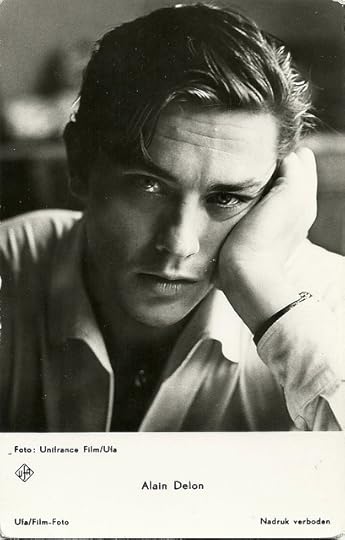
Dutch postcard by Gebr. Spanjersberg, Rotterdam, no. 1383. Photo: Unifrance Film / Ufa.
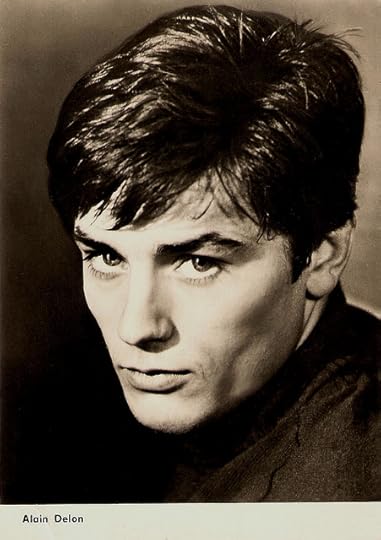
East-German postcard by VEB Progress Film-Vertrieb, Berlin, 1967. retail price: 0,20 MDN.Photo: publicity still for Rocco e i suoi fratelli/Rocco and his brothers (Luchino Visconti, 1960).
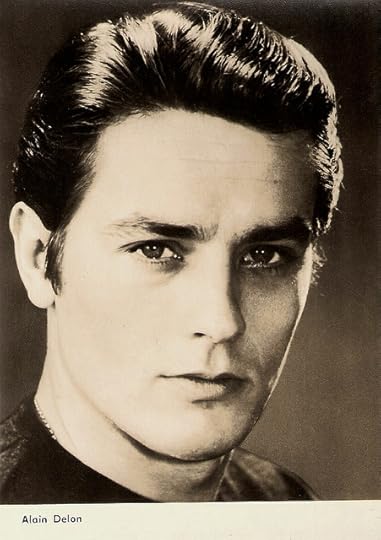
East-German postcard by VEB Progress Film-Vertrieb, Berlin, no. 2529, 1965. retail price: 0,20 MDN.
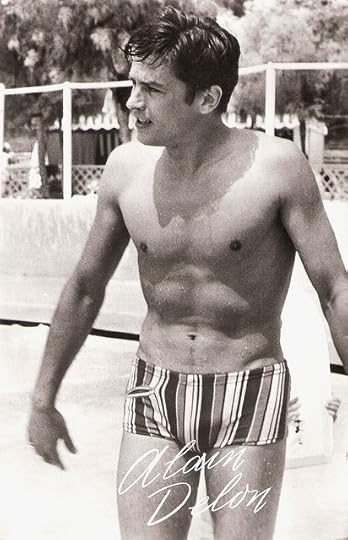
Dutch postcard by 't Sticht, Utrecht, no. 6176.
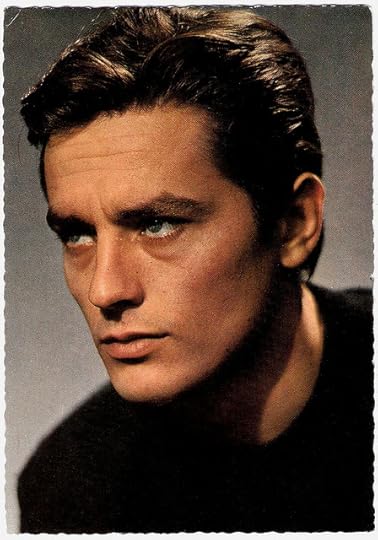
French postcard by E.D.U.G., no. 469. Photo: Sam Lévin.
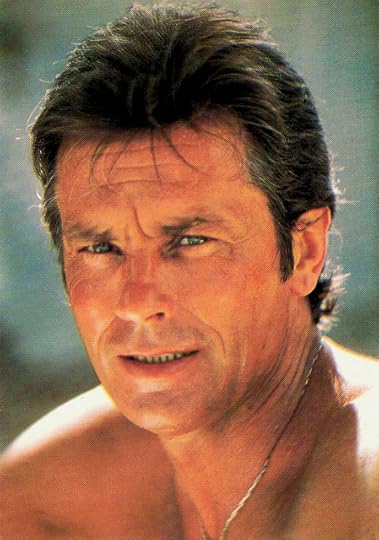
French postcard by Editions P.I., Paris, no. 3453. Photo: Michel Ginfray.

Dutch postcard by Gebr. Spanjersberg, Rotterdam, no. 1383. Photo: Unifrance Film / Ufa.

East-German postcard by VEB Progress Film-Vertrieb, Berlin, 1967. retail price: 0,20 MDN.Photo: publicity still for Rocco e i suoi fratelli/Rocco and his brothers (Luchino Visconti, 1960).

East-German postcard by VEB Progress Film-Vertrieb, Berlin, no. 2529, 1965. retail price: 0,20 MDN.

Dutch postcard by 't Sticht, Utrecht, no. 6176.

French postcard by E.D.U.G., no. 469. Photo: Sam Lévin.

French postcard by Editions P.I., Paris, no. 3453. Photo: Michel Ginfray.
Published on November 07, 2013 23:00
November 6, 2013
Georgette de Néry
Georgette de Néry aka de Nérys played Primerose in the sequel, La nouvelle mission de Judex (1916-1917). She didn't appear in the original Judex film, and La nouvelle mission de Judex was probably her only film.

French postcard by Coquemer Gravures, Paris. Cliché Gerschel. Photo: Gaumont. Still for La nouvelle mission de Judex (Louis Feuillade, 1917-1918).
The Raiders Of The Secrets
In La nouvelle mission de Judex most characters from Judex return: Judex ( René Cresté ), Jacqueline ( Yvette Andreyor ), her father Favraux (Louis Leubas), clumsy Cocantin ( Marcel Levesque ), little Jean (Olinda Mano) and Roger ( Edouard Mathé ).
Jacques/Judex has married Jacqueline, so he has become a father to her son Jean. Jacques' brother Roger loves a neighbour girl Primerose (Georgette de Néry), whose father is the inventor Milton (Emile Keppens).
Their happiness is threatened by the dangerous gang La rafle aux secrets (the raiders of the secrets), avid to steal and resell important technological inventions. The evil Dr. Howey (Andrew Brunelle) and his accomplice, the dangerous Baronne d'Apremont (Juana Borguèse), both have the capacities to hypnotise the innocent Jacqueline and Primerose, and make them do things against their will.
Jacqueline threatens to poison her already ill son, while Primerose steals her father's invention and kidnaps little Jean. The Baronne and her female aid Gaby (Cyprian Gilles) hold Jean, but they are captured and imprisoned by Judex and Cocantin, Gaby repents but the unrepentant Baronne escapes. Dr. Hewey and the Baronne die when their boat explodes, accidentally caused by Cocantin.
In the end Primerose is cured and marries Roger. Remarkable is that the theft of the invention seems an excuse to display the hysterical crises and hypnotised states of the women, while the Baronne and Gaby seem to be very close to another and the previous strict boundaries between good woman/bad woman in Judex are blurred.

French postcard by Coquemer Gravures. Photo: Production Gaumont. Still for La nouvelle mission de Judex (Louis Feuillade, 1917-1918).
Source: Vicki Callahan, Zones of Anxiety: Movement, Musidora and the Crime Serals of Louis Feuillade.

French postcard by Coquemer Gravures, Paris. Cliché Gerschel. Photo: Gaumont. Still for La nouvelle mission de Judex (Louis Feuillade, 1917-1918).
The Raiders Of The Secrets
In La nouvelle mission de Judex most characters from Judex return: Judex ( René Cresté ), Jacqueline ( Yvette Andreyor ), her father Favraux (Louis Leubas), clumsy Cocantin ( Marcel Levesque ), little Jean (Olinda Mano) and Roger ( Edouard Mathé ).
Jacques/Judex has married Jacqueline, so he has become a father to her son Jean. Jacques' brother Roger loves a neighbour girl Primerose (Georgette de Néry), whose father is the inventor Milton (Emile Keppens).
Their happiness is threatened by the dangerous gang La rafle aux secrets (the raiders of the secrets), avid to steal and resell important technological inventions. The evil Dr. Howey (Andrew Brunelle) and his accomplice, the dangerous Baronne d'Apremont (Juana Borguèse), both have the capacities to hypnotise the innocent Jacqueline and Primerose, and make them do things against their will.
Jacqueline threatens to poison her already ill son, while Primerose steals her father's invention and kidnaps little Jean. The Baronne and her female aid Gaby (Cyprian Gilles) hold Jean, but they are captured and imprisoned by Judex and Cocantin, Gaby repents but the unrepentant Baronne escapes. Dr. Hewey and the Baronne die when their boat explodes, accidentally caused by Cocantin.
In the end Primerose is cured and marries Roger. Remarkable is that the theft of the invention seems an excuse to display the hysterical crises and hypnotised states of the women, while the Baronne and Gaby seem to be very close to another and the previous strict boundaries between good woman/bad woman in Judex are blurred.

French postcard by Coquemer Gravures. Photo: Production Gaumont. Still for La nouvelle mission de Judex (Louis Feuillade, 1917-1918).
Source: Vicki Callahan, Zones of Anxiety: Movement, Musidora and the Crime Serals of Louis Feuillade.
Published on November 06, 2013 23:00
November 5, 2013
Madeleine Carroll
British actress Madeleine Carroll (1906–1987) was a beauty of ladylike demeanour. The first of Alfred Hitchcock's ‘ice-cool blondes’ was immensely popular in the 1930s and 1940s. She was nicknamed 'The Queen of British Cinema'. Then Paramount made her the highest-paid Hollywood actress of her time.
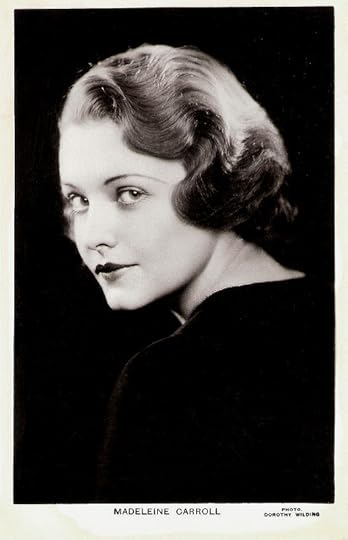
British postcard by Real Photograph, London in the Picturegoer series, no. 352b. Photo: Dorothy Wilding.
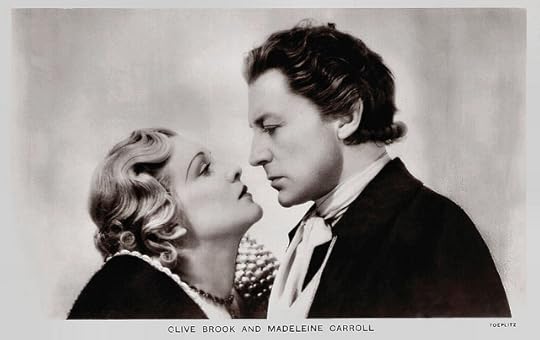
British postcard by Real Photograph, London in the Film Partners series, no. P 166. Photo: Toeplitz.
Sophisticated Style
Madeleine Carroll was born as Edith Madeleine Carroll in West Bromwich, England, in 1906. She was the elder of two children of an Irish professor of languages and his French wife.
She graduated from the University of Birmingham. Her father wanted her to be a French teacher, but she defied him and became an actress. She appeared on stage from 1927.
Her aristocratic allure and sophisticated style were first glimpsed by British cinema audiences in The Guns of Loos (Sinclair Hill, 1928).
She graced such popular films of the early 1930s as the elaborate Titanic-like adventure Atlantic (Ewald André Dupont, 1929), Young Woodley (Thomas Bentley, 1930), based on John Van Druten's play, and The School for Scandal (Thorold Dickinson, Maurice Elvey, 1930).
By the end of 1931 she was considered the top female star in the British film industry and it was somewhat of a shock when she announced her retirement from the screen, due to her recent marriage to Philip Astley of The King's Guards, the first of her four husbands.
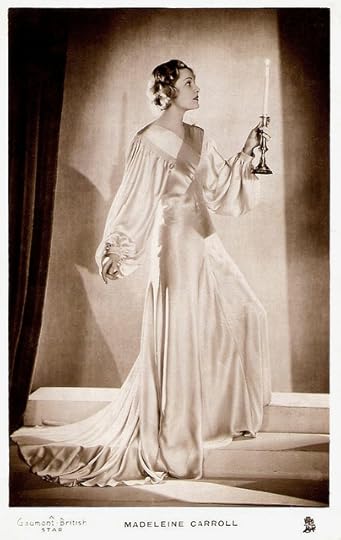
British postcard by Raphael Tuck & Sons in the series Real Photograph, no. 7-8. Photo: Gaumont-British.
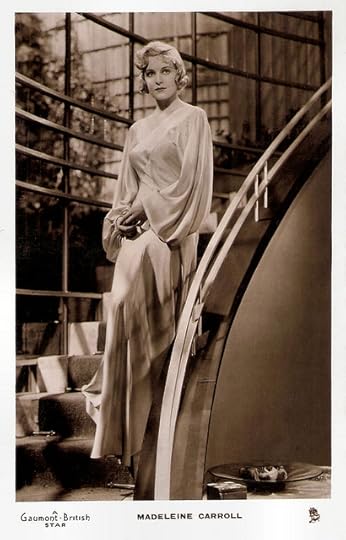
British postcard by Raphael Tuck & Sons, no. 53-8. Photo: Gaumont-British.
Cool, Glib, Intelligent Blonde
But when Gaumont-British offered Madeleine Carroll a reputed £650 pounds a week contract in 1933, she relented and made Sleeping Car (1933, Anatole Litvak) opposite Ivor Novello , and the WW I drama I Was A Spy (1933, Victor Saville), with Conrad Veidt and Herbert Marshall .
I was a Spy was by far her biggest success up to that time. The British Film Weekly selected her as Best Actress of the Year.
She attracted the attention of Alfred Hitchcock, and in 1935 she starred as one of the director's earliest prototypical cool, glib, intelligent blondes in The 39 Steps (1935, Alfred Hitchcock), based on the seminal espionage novel by John Buchan. The film became a sensation and with it, so did Carroll, as the hand-cuffed heroine.
Hitchcock wanted to re-team Carroll with her 39 Steps co-star Robert Donat the following year in Secret Agent (1936, Alfred Hitchcock), a spy thriller based on a work by W. Somerset Maugham.
However, Donat's recurring health problems prevented him from accepting the role and, instead, Hitchcock paired Carroll with John Gielgud . Secret Agent had hardly the critical and box office success of its predecessor, but it enhanced her reputation.
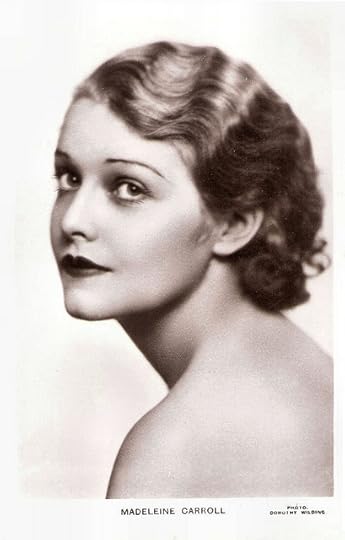
British postcard by Real Photograph, London in the Picturegoer series, no. 352a. Photo: Dorothy Wilding.
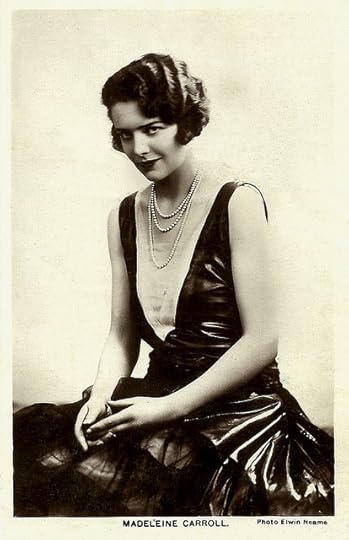
British postcard. Photo Edward Neame.
Highest-paid Hollywood Actress
Poised for international stardom, Madeleine Carroll was the first British beauty to be offered a major American film contract. She accepted a lucrative deal with Paramount Pictures, and became the highest-paid Hollywood actress of her time. Her salary in 1938 was reported to be over $250,000.
She starred opposite Gary Cooper in the adventure The General Died at Dawn (Lewis Milestone, 1936) and with Ronald Colman in the box-office hit The Prisoner of Zenda (John Cromwell, 1937).
She tried a big musical On The Avenue (Roy Del Ruth, 1937) opposite Dick Powell, but other films, including One Night in Lisbon (Edward H. Griffith, 1941) with Fred McMurray, and the Bob Hope vehicle My Favorite Blonde (Sidney Lanfield, 1942), were less prestigious.
In 1942 she married Sterling Hayden, and in 1943 she became a citizen of the United States.

French postcard by Erpé, no. 331. Photo: Fox Film.

French postcard by Editions P.I. Paris, no. 212, 1950. Photo: Paramount Pictures.
War Relief Work
Following her sister Marguerite's death during the Blitz, Madeleine Carroll gave up filming for war relief work.
During WWII, Madeleine Carroll donated her chateau outside Paris to more than 150 'adopted' orphans. She also arranged groups of young people in California to knit clothing for them. In a RKO-Pathe News bulletin, she was filmed at the chateau with the children and staff wearing the clothes, where she thanked people who had contributed.
Later she was honoured for her wartime and postwar efforts by France with the Legion d'Honneur and also by the USA with the American Medal of Freedom.
She made only three further films, including the British alpine-set romance, White Cradle Inn (Harold French, 1947). Her final film was The Fan (Otto Preminger, 1949), adapted from Oscar Wilde's Lady Windermere's Fan.
For her contribution to the motion picture industry, Madeleine Carroll has a star on the Hollywood Walk of Fame. A commemorative monument and plaques were unveiled in her birthplace, West Bromwich, to mark the centenary of her birth.
Madeleine Carroll lived in Paris during her retirement and died in 1987 from pancreatic cancer in Marbella, Spain, aged 81. Her four husbands included actor Sterling Hayden and French film producer Henri Lavorel.

British postcard by Godfrey Philips Associated brands, no. 32. (the postcard appeared in larger packings of DE RESZKE Cigarettes and other brands of Godfrey Phillips Associated brands). Photo: Gaumont-British.
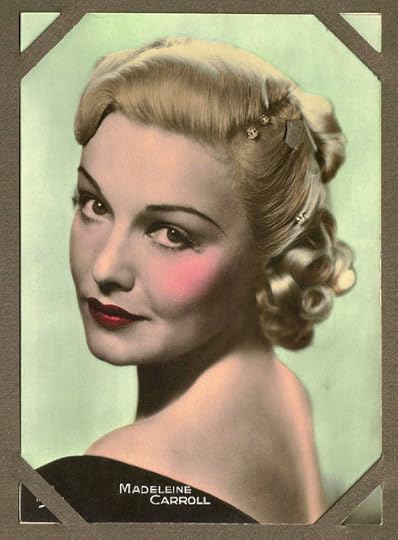
French card by Massilia. Collection: Amit Benyovits.
Sources: Madeleine Carroll–Official tribute Website, Brian McFarlane (Encyclopedia of British Cinema), Wikipedia, and .

British postcard by Real Photograph, London in the Picturegoer series, no. 352b. Photo: Dorothy Wilding.

British postcard by Real Photograph, London in the Film Partners series, no. P 166. Photo: Toeplitz.
Sophisticated Style
Madeleine Carroll was born as Edith Madeleine Carroll in West Bromwich, England, in 1906. She was the elder of two children of an Irish professor of languages and his French wife.
She graduated from the University of Birmingham. Her father wanted her to be a French teacher, but she defied him and became an actress. She appeared on stage from 1927.
Her aristocratic allure and sophisticated style were first glimpsed by British cinema audiences in The Guns of Loos (Sinclair Hill, 1928).
She graced such popular films of the early 1930s as the elaborate Titanic-like adventure Atlantic (Ewald André Dupont, 1929), Young Woodley (Thomas Bentley, 1930), based on John Van Druten's play, and The School for Scandal (Thorold Dickinson, Maurice Elvey, 1930).
By the end of 1931 she was considered the top female star in the British film industry and it was somewhat of a shock when she announced her retirement from the screen, due to her recent marriage to Philip Astley of The King's Guards, the first of her four husbands.

British postcard by Raphael Tuck & Sons in the series Real Photograph, no. 7-8. Photo: Gaumont-British.

British postcard by Raphael Tuck & Sons, no. 53-8. Photo: Gaumont-British.
Cool, Glib, Intelligent Blonde
But when Gaumont-British offered Madeleine Carroll a reputed £650 pounds a week contract in 1933, she relented and made Sleeping Car (1933, Anatole Litvak) opposite Ivor Novello , and the WW I drama I Was A Spy (1933, Victor Saville), with Conrad Veidt and Herbert Marshall .
I was a Spy was by far her biggest success up to that time. The British Film Weekly selected her as Best Actress of the Year.
She attracted the attention of Alfred Hitchcock, and in 1935 she starred as one of the director's earliest prototypical cool, glib, intelligent blondes in The 39 Steps (1935, Alfred Hitchcock), based on the seminal espionage novel by John Buchan. The film became a sensation and with it, so did Carroll, as the hand-cuffed heroine.
Hitchcock wanted to re-team Carroll with her 39 Steps co-star Robert Donat the following year in Secret Agent (1936, Alfred Hitchcock), a spy thriller based on a work by W. Somerset Maugham.
However, Donat's recurring health problems prevented him from accepting the role and, instead, Hitchcock paired Carroll with John Gielgud . Secret Agent had hardly the critical and box office success of its predecessor, but it enhanced her reputation.

British postcard by Real Photograph, London in the Picturegoer series, no. 352a. Photo: Dorothy Wilding.

British postcard. Photo Edward Neame.
Highest-paid Hollywood Actress
Poised for international stardom, Madeleine Carroll was the first British beauty to be offered a major American film contract. She accepted a lucrative deal with Paramount Pictures, and became the highest-paid Hollywood actress of her time. Her salary in 1938 was reported to be over $250,000.
She starred opposite Gary Cooper in the adventure The General Died at Dawn (Lewis Milestone, 1936) and with Ronald Colman in the box-office hit The Prisoner of Zenda (John Cromwell, 1937).
She tried a big musical On The Avenue (Roy Del Ruth, 1937) opposite Dick Powell, but other films, including One Night in Lisbon (Edward H. Griffith, 1941) with Fred McMurray, and the Bob Hope vehicle My Favorite Blonde (Sidney Lanfield, 1942), were less prestigious.
In 1942 she married Sterling Hayden, and in 1943 she became a citizen of the United States.

French postcard by Erpé, no. 331. Photo: Fox Film.

French postcard by Editions P.I. Paris, no. 212, 1950. Photo: Paramount Pictures.
War Relief Work
Following her sister Marguerite's death during the Blitz, Madeleine Carroll gave up filming for war relief work.
During WWII, Madeleine Carroll donated her chateau outside Paris to more than 150 'adopted' orphans. She also arranged groups of young people in California to knit clothing for them. In a RKO-Pathe News bulletin, she was filmed at the chateau with the children and staff wearing the clothes, where she thanked people who had contributed.
Later she was honoured for her wartime and postwar efforts by France with the Legion d'Honneur and also by the USA with the American Medal of Freedom.
She made only three further films, including the British alpine-set romance, White Cradle Inn (Harold French, 1947). Her final film was The Fan (Otto Preminger, 1949), adapted from Oscar Wilde's Lady Windermere's Fan.
For her contribution to the motion picture industry, Madeleine Carroll has a star on the Hollywood Walk of Fame. A commemorative monument and plaques were unveiled in her birthplace, West Bromwich, to mark the centenary of her birth.
Madeleine Carroll lived in Paris during her retirement and died in 1987 from pancreatic cancer in Marbella, Spain, aged 81. Her four husbands included actor Sterling Hayden and French film producer Henri Lavorel.

British postcard by Godfrey Philips Associated brands, no. 32. (the postcard appeared in larger packings of DE RESZKE Cigarettes and other brands of Godfrey Phillips Associated brands). Photo: Gaumont-British.

French card by Massilia. Collection: Amit Benyovits.
Sources: Madeleine Carroll–Official tribute Website, Brian McFarlane (Encyclopedia of British Cinema), Wikipedia, and .
Published on November 05, 2013 23:00
November 4, 2013
Rowan Atkinson
Funny English actor and screenwriter Rowan Atkinson (1955) is best known for his much-loved historical sitcom Blackadder (1983-1989) and for the series around the clumsy, face-pulling Mr. Bean (1990-1995). The black-haired, bug-eyed, and weak-chinned comedian had also success in the cinema with Bean (1997), the sequel Mr. Bean's Holiday (2007) and with his James Bond parody Johnny English (2003).

Dutch postcard by Interstat, Amsterdam. Sent by mail in 2001. Photo: Tiger Television, 1998.
The Black Adder
Rowan Sebastian Atkinson was born on Consett, England in 1955. He wat the youngest of the four sons of Eric Atkinson, a farmer and company director, and Ella May (née Bainbridge). Like his father, he studied Electrical Engineering at The Queen's College, Oxford.
He also performed and wrote for the revue group of the Experimental Theatre Club (ETC) and for the Oxford University Dramatic Society (OUDS). There he met writer Richard Curtis and composer Howard Goodall, with whom he would continue to collaborate during his career. In 1976, he got national attention in the Oxford Revue at the Edinburgh Festival Fringe.
Atkinson starred in The Atkinson People (1978), a series of comedy shows for BBC Radio 3. The series of satirical interviews with fictional great men was written by Atkinson and Richard Curtis, and produced by Griff Rhys Jones.
On TV, he first came to prominence in BBC's satirical sketch show Not the Nine O'Clock News (1979–1982), and on stage and screen via his participation with members of Monty Python in The Secret Policeman's Balls (1979 and 1982) for the British section of Amnesty International. His performances in Not the Nine O'Clock News earned Atkinson a British Academy Award and got him designated 'BBC Personality of the Year' in 1980.
This success led to the lead role as the cowardly scheming Prince Edmund in the medieval sitcom The Black Adder (1983), which he also co-wrote with Richard Curtis. Black-Adder II (1986) followed the fortunes of one of the descendants of Atkinson's original character, this time in the Elizabethan era. Other sequels were Black Adder the Third (1987), set in the Regency era, and Blackadder Goes Forth (1989), set in World War I. The Blackadder series became one of the most successful of all BBC situation comedies, spawning several television specials.

Dutch postcard by Interstat, Amsterdam. Photo: Polygram / CPL.

British postcard by Heroes Publishing Ltd., London, no. SPC 3142.
Mr. Bean
Rowan Atkinson's other creation, the hapless Mr. Bean, first appeared on New Year's Day in 1990 in a half-hour special for Thames Television. Several sequels to Mr. Bean appeared on television until 1995.
Sandra Brennan at AllMovie : “Different from other shows in that it was largely silent, Atkinson's Bean demonstrated a rare gift for slapstick that has led to his being compared to Buster Keaton and Charlie Chaplin. During its six year run, Mr. Bean became the most popular show in the U.K. and has since been shown in 89 countries where it has gained a cult following comparable to Monty Python and Fawlty Towers.”
The character later appeared in the feature film Bean/Bean: The Ultimate Disaster Movie (Mel Smith, 1997), for which Atkinson was also the writer and executive producer. It was an international box office hit. A second film, Mr. Bean's Holiday (Steve Bendelack, 2007) also became an international success.
Atkinson also portrayed Inspector Raymond Fowler in the TV sitcom The Thin Blue Line (1995-1996), written by Ben Elton. The Thin Blue Line takes place in a police station located in fictitious Gasforth.
Atkinson's film career had begun with a supporting part in the 'unofficial' James Bond movie Never Say Never Again (Irvin Kershner, 1983) starring Sean Connery , and a leading role in the short comedy Dead on Time (Lyndall Hobbs, 1983) with Nigel Hawthorne.
He appeared in Mel Smith's directorial debut, the romantic comedy The Tall Guy (1989) with Jeff Goldblum, and in Roald Dahl's The Witches (Nicolas Roeg, 1990) alongside Anjelica Huston and Mai Zetterling .
He played the part of Dexter Hayman in Hot Shots! Part Deux (Jim Abrahams, 1993), a parody of Rambo III, starring Charlie Sheen, and appeared as the hilariously verbally bumbling vicar in Four Weddings and a Funeral (Mike Newell, 1994). This romantic comedy starring Hugh Grant received an Academy Award nomination for Best Picture and became an unexpected box office hit. It even became the highest-grossing British film in cinema history at the time, with worldwide earnings of $245.7 million.
In Disney's The Lion King (Roger Allers, Rob Minkoff, 1994) Atkinson featured as the voice of Zazu the Red-billed Hornbill. He also starred in Doctor Who and the Curse of Fatal Death (1999), a comedy spoof of Doctor Who for a ‘Red Nose Day’ benefit.

British postcard by Pyramid, Leicester, no. 8223. Photo: Hugh Thompson.

German postcard by Fun-Tasia, Köln, no. BPK 5017. Photo: Tiger Television, 1998.
Johnny English
Rowan Atkinson has been listed in The Observer as one of the 50 funniest actors in British comedy and amongst the top 50 comedians ever, in a 2005 poll of fellow comedians. He continued to appear in supporting roles in film comedies, including Maybe Baby (Ben Elton, 2000) starring Hugh Laurie, Rat Race (Jerry Zucker, 2001) with John Cleese, and the hit Love Actually (Richard Curtis, 2003) with an ensemble cast including Hugh Grant, Liam Neeson, Colin Firth and Emma Thompson.
He also appeared as a reverend in the crime comedy Keeping Mum (Niall Johnson, 2005), which also starred Kristin Scott Thomas, Maggie Smith and Patrick Swayze.
Atkinson fronted campaigns for Give Blood (1989), Fujifilm (1999), and Kronenbourg (1999). From 1991 on, Atkinson also appeared as a hapless and error-prone espionage agent in a long-running series for Barclaycard.
On this James Bond spoof, the Johnny English character was based, which featured in the successful film Johnny English (Peter Howitt, 2003) and its sequel Johnny English Reborn (Oliver Parker, 2011). Both films got mixed reviews, but were huge successes at the international box offices.
Atkinson appeared at the 2012 Summer Olympics opening ceremony as Mr. Bean in a comedy sketch during a performance of Chariots of Fire, playing a repeated single note on synthesiser. He then lapsed into a dream sequence in which he joined the runners from the film of the same name (about the 1924 Summer Olympics), beating them in their iconic run along West Sands at St. Andrews, by riding in a minicab and tripping the front runner.
In 2013, Rowan Atkinson took on the titular role of the Simon Gray play Quartermaine's Terms at Wyndham's Theatre in London. The production was directed by Richard Eyre.
Rowan Atkinson is married to make-up artist Sunetra Sastry They have two children, Benjamin (1993) and Lily (1995). Atkinson was appointed Commander of the Order of the British Empire (CBE) in 2013.

British postcard by Pyramid, Leicester, no. PC 2100.
Sources: Sandra Brennan (AllMovie), Dick Fiddy (BFI ScreenOnline), Wikipedia and .

Dutch postcard by Interstat, Amsterdam. Sent by mail in 2001. Photo: Tiger Television, 1998.
The Black Adder
Rowan Sebastian Atkinson was born on Consett, England in 1955. He wat the youngest of the four sons of Eric Atkinson, a farmer and company director, and Ella May (née Bainbridge). Like his father, he studied Electrical Engineering at The Queen's College, Oxford.
He also performed and wrote for the revue group of the Experimental Theatre Club (ETC) and for the Oxford University Dramatic Society (OUDS). There he met writer Richard Curtis and composer Howard Goodall, with whom he would continue to collaborate during his career. In 1976, he got national attention in the Oxford Revue at the Edinburgh Festival Fringe.
Atkinson starred in The Atkinson People (1978), a series of comedy shows for BBC Radio 3. The series of satirical interviews with fictional great men was written by Atkinson and Richard Curtis, and produced by Griff Rhys Jones.
On TV, he first came to prominence in BBC's satirical sketch show Not the Nine O'Clock News (1979–1982), and on stage and screen via his participation with members of Monty Python in The Secret Policeman's Balls (1979 and 1982) for the British section of Amnesty International. His performances in Not the Nine O'Clock News earned Atkinson a British Academy Award and got him designated 'BBC Personality of the Year' in 1980.
This success led to the lead role as the cowardly scheming Prince Edmund in the medieval sitcom The Black Adder (1983), which he also co-wrote with Richard Curtis. Black-Adder II (1986) followed the fortunes of one of the descendants of Atkinson's original character, this time in the Elizabethan era. Other sequels were Black Adder the Third (1987), set in the Regency era, and Blackadder Goes Forth (1989), set in World War I. The Blackadder series became one of the most successful of all BBC situation comedies, spawning several television specials.

Dutch postcard by Interstat, Amsterdam. Photo: Polygram / CPL.

British postcard by Heroes Publishing Ltd., London, no. SPC 3142.
Mr. Bean
Rowan Atkinson's other creation, the hapless Mr. Bean, first appeared on New Year's Day in 1990 in a half-hour special for Thames Television. Several sequels to Mr. Bean appeared on television until 1995.
Sandra Brennan at AllMovie : “Different from other shows in that it was largely silent, Atkinson's Bean demonstrated a rare gift for slapstick that has led to his being compared to Buster Keaton and Charlie Chaplin. During its six year run, Mr. Bean became the most popular show in the U.K. and has since been shown in 89 countries where it has gained a cult following comparable to Monty Python and Fawlty Towers.”
The character later appeared in the feature film Bean/Bean: The Ultimate Disaster Movie (Mel Smith, 1997), for which Atkinson was also the writer and executive producer. It was an international box office hit. A second film, Mr. Bean's Holiday (Steve Bendelack, 2007) also became an international success.
Atkinson also portrayed Inspector Raymond Fowler in the TV sitcom The Thin Blue Line (1995-1996), written by Ben Elton. The Thin Blue Line takes place in a police station located in fictitious Gasforth.
Atkinson's film career had begun with a supporting part in the 'unofficial' James Bond movie Never Say Never Again (Irvin Kershner, 1983) starring Sean Connery , and a leading role in the short comedy Dead on Time (Lyndall Hobbs, 1983) with Nigel Hawthorne.
He appeared in Mel Smith's directorial debut, the romantic comedy The Tall Guy (1989) with Jeff Goldblum, and in Roald Dahl's The Witches (Nicolas Roeg, 1990) alongside Anjelica Huston and Mai Zetterling .
He played the part of Dexter Hayman in Hot Shots! Part Deux (Jim Abrahams, 1993), a parody of Rambo III, starring Charlie Sheen, and appeared as the hilariously verbally bumbling vicar in Four Weddings and a Funeral (Mike Newell, 1994). This romantic comedy starring Hugh Grant received an Academy Award nomination for Best Picture and became an unexpected box office hit. It even became the highest-grossing British film in cinema history at the time, with worldwide earnings of $245.7 million.
In Disney's The Lion King (Roger Allers, Rob Minkoff, 1994) Atkinson featured as the voice of Zazu the Red-billed Hornbill. He also starred in Doctor Who and the Curse of Fatal Death (1999), a comedy spoof of Doctor Who for a ‘Red Nose Day’ benefit.

British postcard by Pyramid, Leicester, no. 8223. Photo: Hugh Thompson.

German postcard by Fun-Tasia, Köln, no. BPK 5017. Photo: Tiger Television, 1998.
Johnny English
Rowan Atkinson has been listed in The Observer as one of the 50 funniest actors in British comedy and amongst the top 50 comedians ever, in a 2005 poll of fellow comedians. He continued to appear in supporting roles in film comedies, including Maybe Baby (Ben Elton, 2000) starring Hugh Laurie, Rat Race (Jerry Zucker, 2001) with John Cleese, and the hit Love Actually (Richard Curtis, 2003) with an ensemble cast including Hugh Grant, Liam Neeson, Colin Firth and Emma Thompson.
He also appeared as a reverend in the crime comedy Keeping Mum (Niall Johnson, 2005), which also starred Kristin Scott Thomas, Maggie Smith and Patrick Swayze.
Atkinson fronted campaigns for Give Blood (1989), Fujifilm (1999), and Kronenbourg (1999). From 1991 on, Atkinson also appeared as a hapless and error-prone espionage agent in a long-running series for Barclaycard.
On this James Bond spoof, the Johnny English character was based, which featured in the successful film Johnny English (Peter Howitt, 2003) and its sequel Johnny English Reborn (Oliver Parker, 2011). Both films got mixed reviews, but were huge successes at the international box offices.
Atkinson appeared at the 2012 Summer Olympics opening ceremony as Mr. Bean in a comedy sketch during a performance of Chariots of Fire, playing a repeated single note on synthesiser. He then lapsed into a dream sequence in which he joined the runners from the film of the same name (about the 1924 Summer Olympics), beating them in their iconic run along West Sands at St. Andrews, by riding in a minicab and tripping the front runner.
In 2013, Rowan Atkinson took on the titular role of the Simon Gray play Quartermaine's Terms at Wyndham's Theatre in London. The production was directed by Richard Eyre.
Rowan Atkinson is married to make-up artist Sunetra Sastry They have two children, Benjamin (1993) and Lily (1995). Atkinson was appointed Commander of the Order of the British Empire (CBE) in 2013.

British postcard by Pyramid, Leicester, no. PC 2100.
Sources: Sandra Brennan (AllMovie), Dick Fiddy (BFI ScreenOnline), Wikipedia and .
Published on November 04, 2013 23:00
Paul van Yperen's Blog
- Paul van Yperen's profile
- 13 followers
Paul van Yperen isn't a Goodreads Author
(yet),
but they
do have a blog,
so here are some recent posts imported from
their feed.



